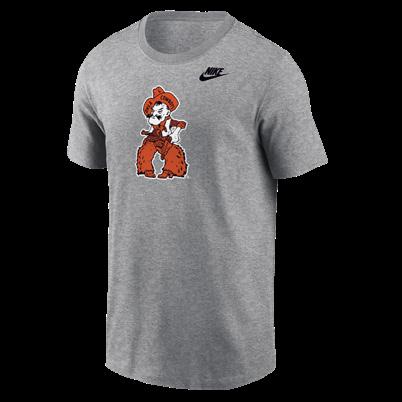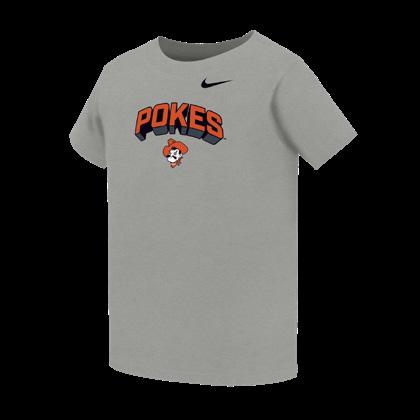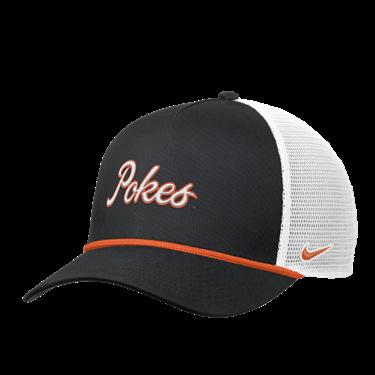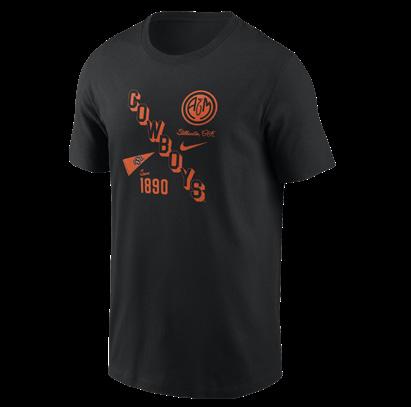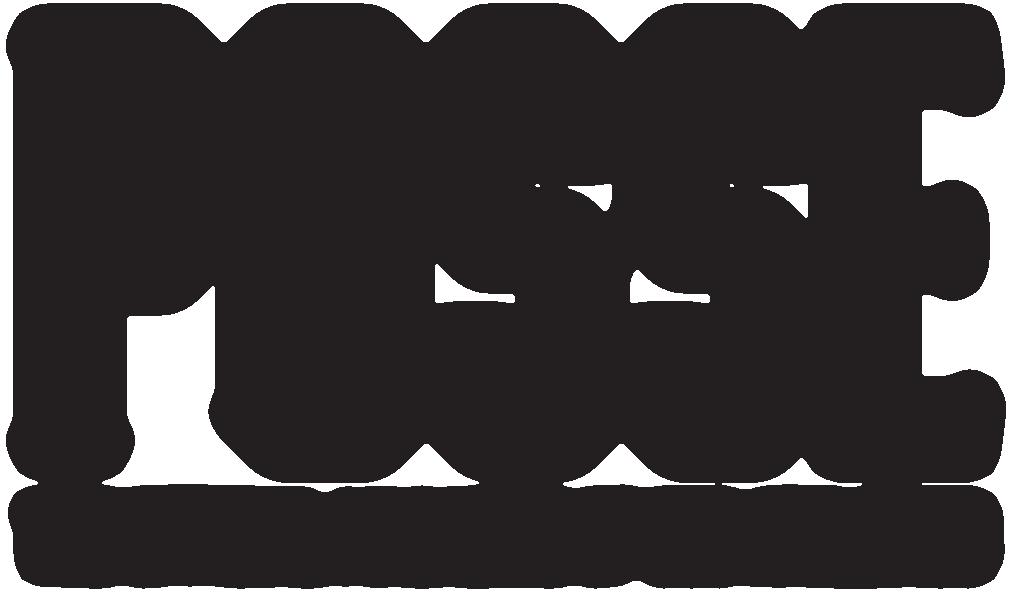
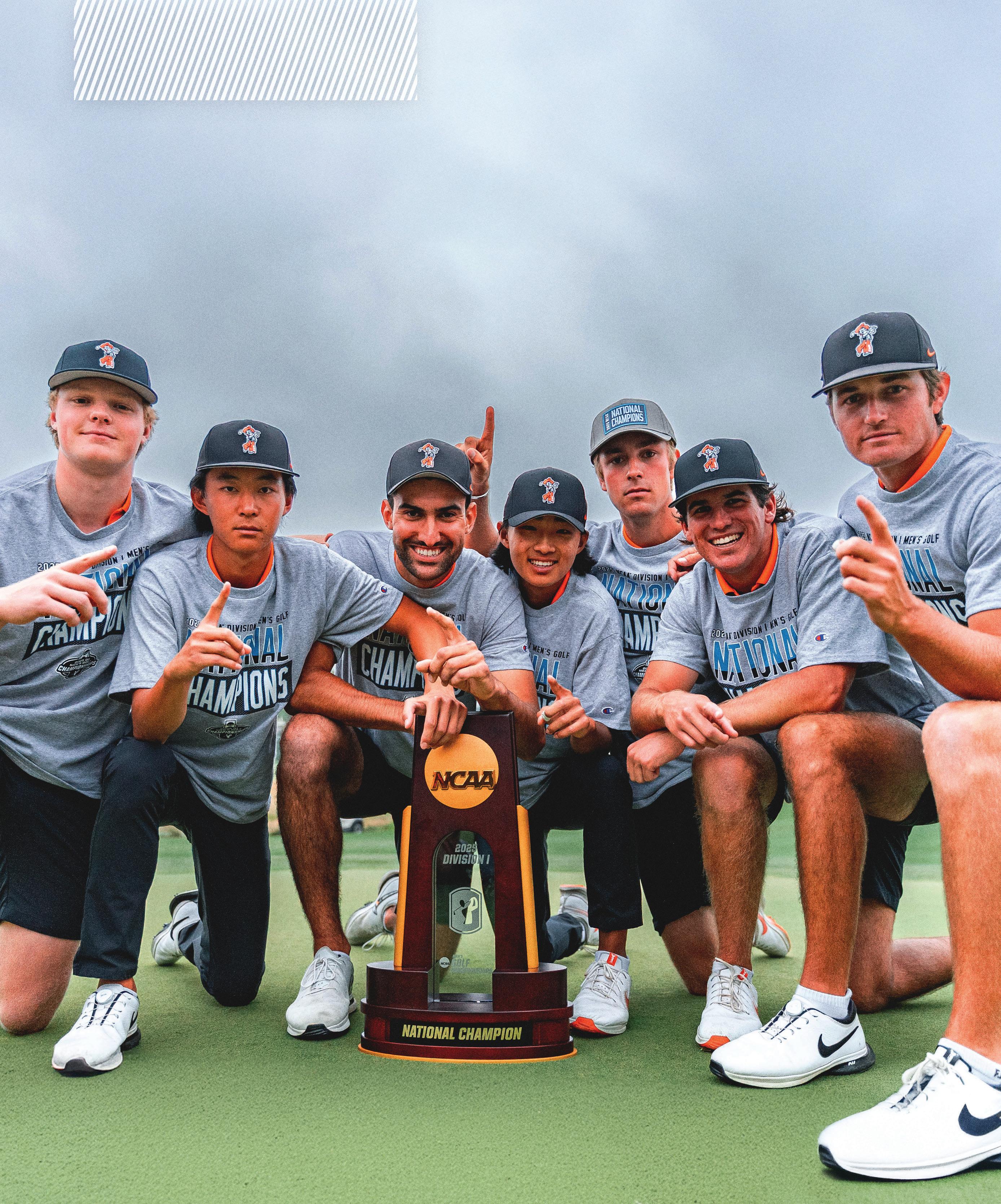
GOL F SCHOOL
COWBOY GOLF C APTU RES 12TH NC A A TE AM CHAM PIONSH I P















COWBOY GOLF C APTU RES 12TH NC A A TE AM CHAM PIONSH I P












BY K E V I N K LI N T WO R T H
Any time an Oklahoma State program wins a national title seems to present an opportunity for introspection into who we are and how we got here. And when you are looking back at Cowboy Golf, fresh o its 12th national championship, the looking back is always good.
For some reason, Oklahoma A&M added a country club sport on a land-grant campus in the middle of the wind-swept prairie in 1947. Labron Harris, who was working in the A&M business school at the time, added men’s golf coach to his duties.
Of course, it all worked like a charm. Actually, it worked better than a charm, since charm insinuates luck. No one gets lucky for 80 years.
The Aggies won their conference championship in each of their first nine years of existence and in 24 of the 27 years in which Harris was the head coach — spanning membership in the Missouri Valley Conference as well as the Big Eight.
Not to be outdone, former Harris pupil Mike Holder won the Big Eight his first 10 years as head coach and 25 times in his 32 years before he moved upstairs (or east on Highway 51) to become athletic director.
Harris led Oklahoma State Golf into the championship circle for the first time in school history when he led the Cowboys to the 1963 national crown . His squads had finished as NCAA runner-up three times before that first title and would finish second again in 1964. The translation is that Oklahoma State won the national title or finished second four times in five years and five times in seven years
Holder once again raised the ante. His first team finished fifth at the NCAAs, but the stage was set for his long run of dominance. Starting in 1975 the Cowboys
completely took over college golf, winning the national title or finishing second 13 times in 14 years. His first five national championships came in 1976, 1978, 1980, 1983 and 1987.
As college golf has grown in profile, and as the pockets of some warm weather schools have gotten deeper, the competition on the course has become tougher. Still, the Cowboys have remained the measuring stick for the rest of America
Over the last 10 years, nine di erent schools have won the national championship in men’s golf. The only two-time winner during that span is Oklahoma State with titles in 2018 and 2025.
There have been a handful of dynasty-type runs in men’s golf. Yale and Ivy League schools dominated the sport in the years before it became part of the NCAA championship portfolio in 1939. North Texas had a run of four straight championships from 1949-1952, and Houston won all 16 of its titles between 1956 and 1985. But with the Cougars’ last championship now 40 years in the rear-view mirror, it would seem clear that the Cowboy program remains the bell cow of college golf. OSU has won at least one national title in seven straight decades, under four di erent head coaches with Mike McGraw and Alan Bratton joining Harris and Holder.
The longest consecutive streak of NCAA championship tournament appearances is 65 by OSU. Houston’s streak of 36 is second.
The most top-10 team finishes in NCAA history is 63 by OSU. Arizona State
is second with 37.
The most top-five team finishes by a program are 58 by OSU. Houston is second with 28.

Need more numbers? Me either.
All of these accolades can only lead to one conclusion. Those folks on campus in 1947 really knew what they were doing.






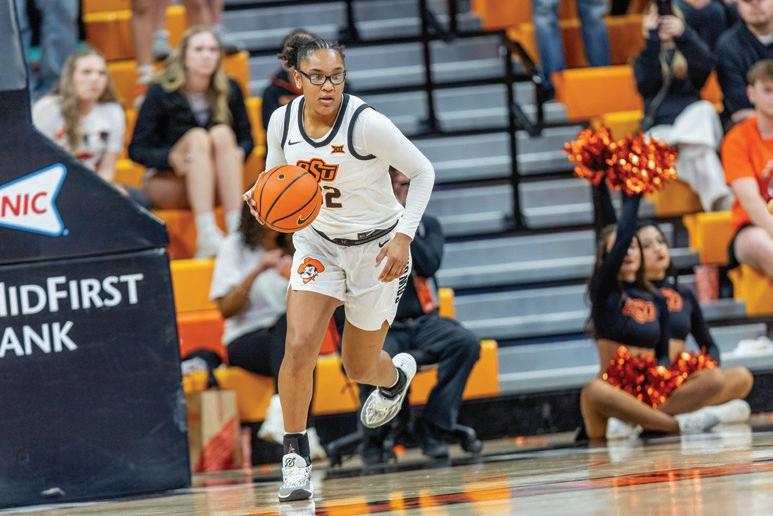

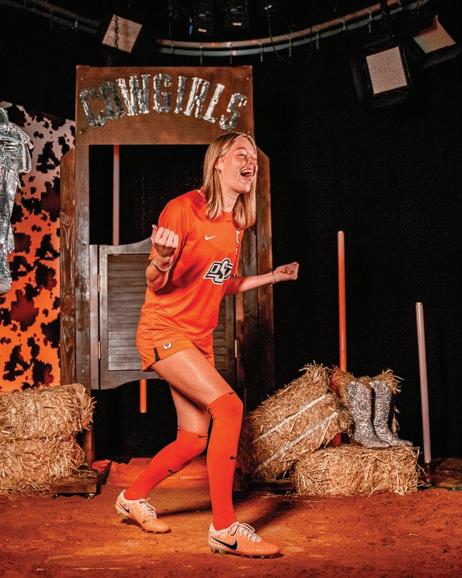
Cowboy Trent Howland, a redshirt senior from Joliet, Ill., takes reps during OSU's fall camp.
The 6-foot-2, 247-pound running back averaged 5.6 yards per carry as a backup to Ollie Gordon II in 2024 and looks to have a prominent role in the backfield this season.

POSSE Magazine Sta
EDITOR-IN-CHIEF / SENIOR ASSOCIATE ATHLETIC DIRECTOR KEVIN KLINTWORTH
SENIOR ASSOCIATE ATHLETIC DIRECTOR JESSE MARTIN
ART DIRECTOR / DESIGNER JORDAN SMITH
PHOTOGRAPHER / PRODUCTION ASSISTANT BRUCE WATERFIELD
ASSISTANT EDITOR CLAY BILLMAN
CONTRIBUTING PHOTOGRAPHERS EVAN CICHON, HABBIE COLEN, JAIDEN DAUGHTY, CHASE DAVIS, MASON HARBOUR, GARY LAWSON, COLIN PETERS, CHLOE REEVES
PHIL SHOCKLEY, HEATH VESSELS, KYLIE VINSON
CONTRIBUTING WRITERS CLAY BILLMAN, RYAN CAMERON, HALLIE HART, KEVIN KLINTWORTH, GAVIN LANG, TYLER WALDREP
Development (POSSE) Sta
ASSOCIATE AD / ANNUAL GIVING ELLEN AYRES
PUBLICATIONS COORDINATOR CLAY BILLMAN
ASSOCIATE AD / DEVELOPMENT BRAKSTON BROCK
ASSOCIATE AD / DEVELOPMENT MATT GRANTHAM
ASSOCIATE AD / DEVELOPMENT DANIEL HEFLIN
SENIOR ASSOCIATE AD / EXTERNAL AFFAIRS JESSE MARTIN
SENIOR ASSOCIATE AD / DEVELOPMENT LARRY REECE
ASSOCIATE AD / DEVELOPMENT SHAWN TAYLOR
ASSISTANT DIRECTOR OF ANNUAL GIVING
ATHLETICS PROJECT MANAGER
ASSISTANT DIRECTOR / DONOR BENEFITS
OSU POSSE
102 ATHLETICS CENTER STILLWATER, OK 74078-5070
405.744.7301 P 405.744.9084 F OKSTATE.COM/POSSE POSSE@OKSTATE.EDU
ADVERTISING 405.744.7301
EDITORIAL 405.744.1706
ADDISON UFKES
JEANA WALLER
MORGYN WYNNE
At Oklahoma State University, compliance with NCAA, Big 12 and institutional rules is of the utmost importance. As a supporter of OSU, please remember that maintaining the integrity of the University and the Athletic Department is your first responsibility. As a donor, and therefore booster of OSU, NCAA rules apply to you. If you have any questions, feel free to call the OSU O ce of Athletic Compliance at 405-744-7862 Additional information can also be found by clicking on the Compliance tab of the Athletic Department web-site at okstate.com
Remember to always “Ask Before You Act.”
Respectfully,
BEN DYSON
SENIOR ASSOCIATE ATHLETIC DIRECTOR FOR COMPLIANCE
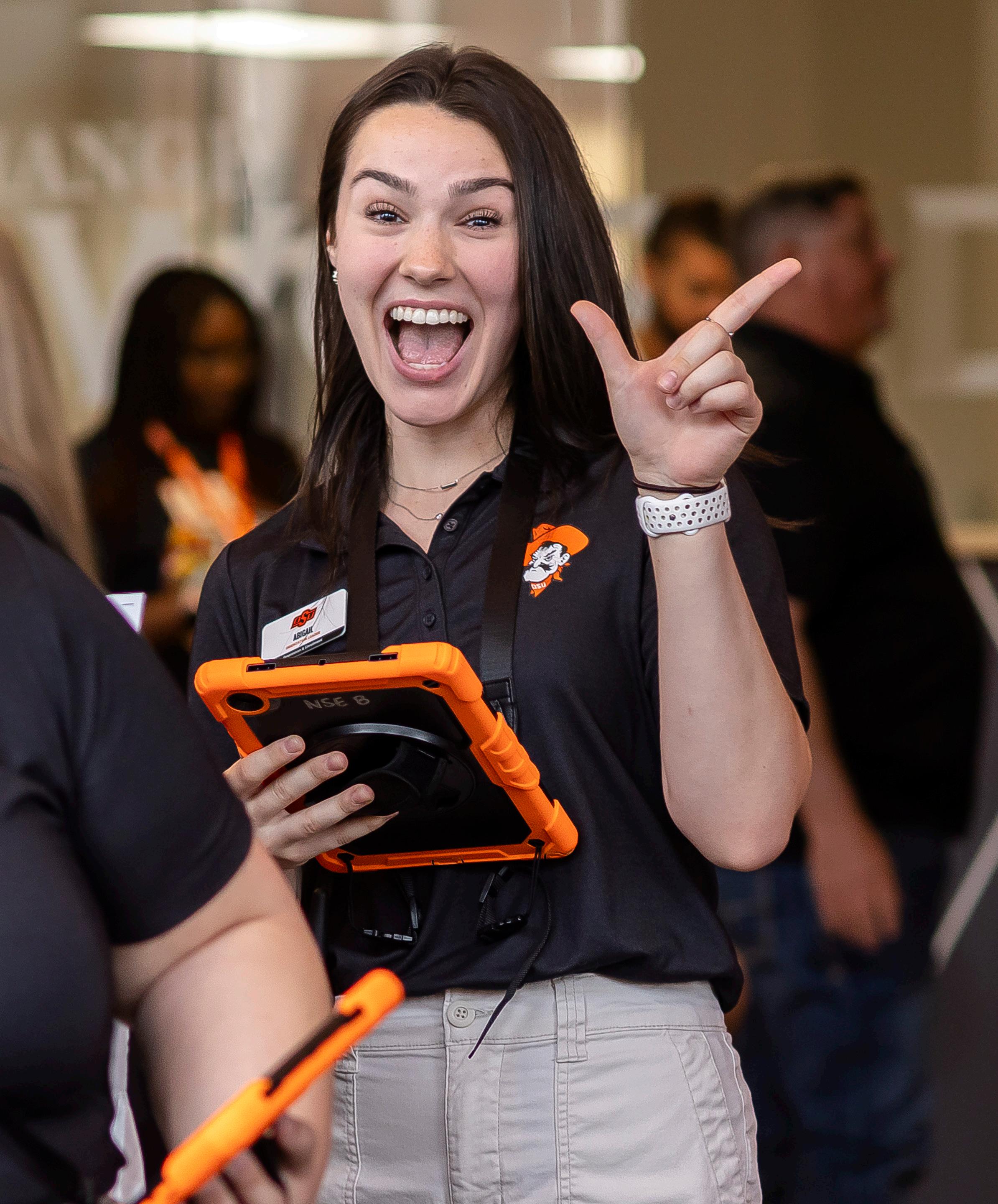
Cowboy Brian Musau followed up his NCAA indoor 5,000 meter title with a win on the outdoor oval. Musau captured the 5,000 meter crown at the 2025 NCAA Outdoor Track & Field Championships, held at Hayward Field in Eugene, Oregon. Musau clocked a time of 13:20.59 in a masterclass of tactics and closing speed, including a 4:01 pace over the final 1600 meters. Teammate Fouad Messaoudi earned First Team All-America honors with an eighth-place time of 13:25.48. Musau's second title marks the 12th NCAA individual champion under OSU Director of Track & Field and Cross Country Dave Smith Runnign for Kenya, the Bowerman Award semifinalist would go on to win the World University Games 10K, held in Bochum, Germany, in July.





Cowboys Iman Oates, Cam Smith and Josh Ford, along with Pistol Pete and senior OSU Pom squad members Jaselyn Rossman and Sydney Hendricks, record a promo video at Big 12 Football Media Days.
The conference's 16 teams converged on Frisco, Texas, July 8-9 for two full days of interviews and content creation at the Ford Center at The Star. The captured footage will be used for in-game messaging, social media content and conference marketing during the upcoming season.

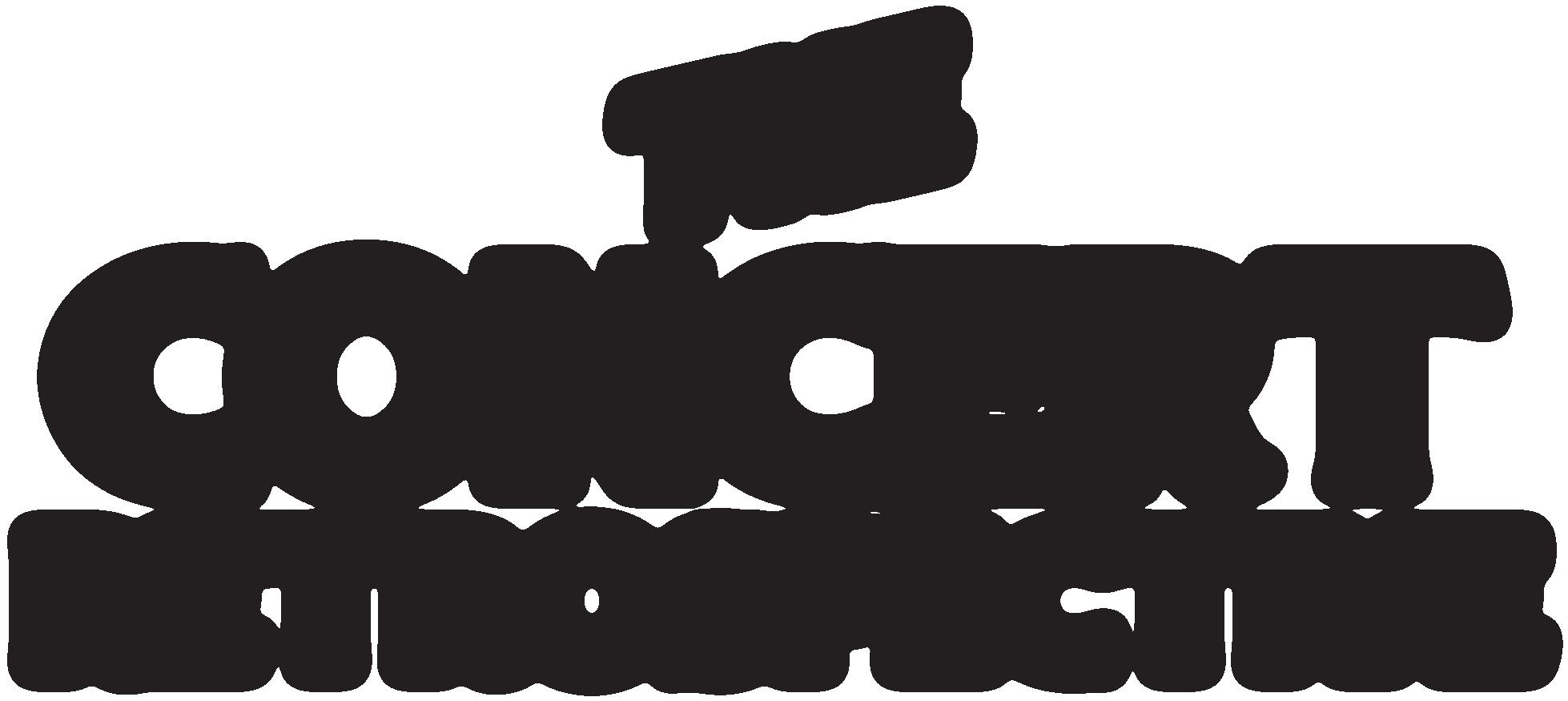




We did it.
Oklahoma State made history by putting on the largest concert event ever in the state of Oklahoma.
More than 200,000 people descended upon Stillwater in April for The Boys from Oklahoma four-day Red Dirt music event headlined by Cross Canadian Ragweed and Turnpike Troubadours and featuring Jason Boland & the Stragglers, The Great Divide, and Stoney LaRue and including on-stage performances from special guests Dierks Bentley, Wyatt Flores, Parker McCollum and more.
At the very core of the event was the reunion of Cross Canadian Ragweed, and there they were, playing live at Boone Pickens Stadium. Head coach Mike Gundy came on stage introduced the band to the crowds of 40,000-plus. One night, lead singer Cody Canada performed in an Oklahoma State basketball jersey. On another, he wore an OSU football jersey. Every night, a Pistol Pete decal was clearly visible on his guitar. This meant something to him. It was personal.
It was a similar scene with Turnpike Troubadours. In between songs at one point, lead singer Evan Felker told the sold-out crowd that “About half of all these songs probably got written while I lived in this town — or at least a whole bunch of them did.”
With energized and inspired performers, the music and the spectacle were amazing, but the impact of the event went far beyond the stage.
The Boys from Oklahoma event drew many fans to Stillwater who had never previously been.
The event itself was like a Red Dirt Woodstock with true national appeal. People flocked to Boone Pickens Stadium from all 50 states, with additional tickets purchased in Canada, Israel and Argentina. Approximately 70 percent of all tickets were purchased by people with no existing ties to OSU.
“The impact, there’s no way to replace the idea of having someone totally new experience your community and have such a great experience on that visit — that’s what we want,” Stillwater mayor Will Joyce said. “We want people to come into town and enjoy it, and then potentially come back another time. That is irreplaceable.”
Once they got to Stillwater, visiting concertgoers found friendly hosts, a well-prepared city, and an outstanding concert venue, both in terms of acoustics and amenities.
A sampling of how that sentiment played out on social media platforms:

“
No local business is more synonymous with Stillwater than Eskimo Joe’s
Stan Clark’s iconic Jumpin’ Little Juke Joint has been around for 50 years, and he said it has never seen anything like what came during The Boys from Oklahoma event.
“The Saturday of that week was the single largest day in the history of Eskimo Joe’s,” Clark said. “To have four days of that strength was unlike anything we’ve ever experienced. It was like four great gamedays in a row.”
Clark said in addition to Saturday being the largest single day, the four-day concert event also produced the largest week in Joe’s history
“It was packed every day, and what was cool about it was it was a music festival crowd versus a competitive football crowd,” he said. “Everyone was just chill, and we loved it. By 1 p.m., we had live music going, and the atmosphere was just really pleasing. Everyone was well-behaved and had a great time.”
IT WAS A SPECIAL MOMENT IN STILLWATER HISTORY. IT WAS AN EXCELLENT VIBE. IT WAS A BEAUTIFUL VENUE, AND I JUST THOUGHT IT WAS EXCEPTIONAL.”
STAN CLARK
Cory Williams grew up in Stillwater and is involved in several notable businesses downtown, including being the owner and operator of Hatch Early Mood Food
He said The Boys from Oklahoma four-day event produced the restaurant’s largest week on record during a time when business typically begins to slow down.
“I felt like everybody was just a lot more relaxed, and coming here felt like a vacation to a lot of them,” Williams said. “I think everybody was exceedingly happy to be where they were and doing what they were doing. There was a lot of patience and understanding and kindness. We just didn’t have a lot of unhappy people coming through the door. Even when you’re telling them, ‘Hey, it’s going to be an hour and 15 minutes for a table,’ they’re okay.”
Williams said The Boys from Oklahoma concerts represented a unique growth opportunity for the community.
“To add something of that magnitude was exceedingly helpful — it was a big deal, especially from an economic standpoint and from a community exposure standpoint,” Williams said. “The ripple e ect it will have is huge. I really do think that there are people looking at Stillwater now to

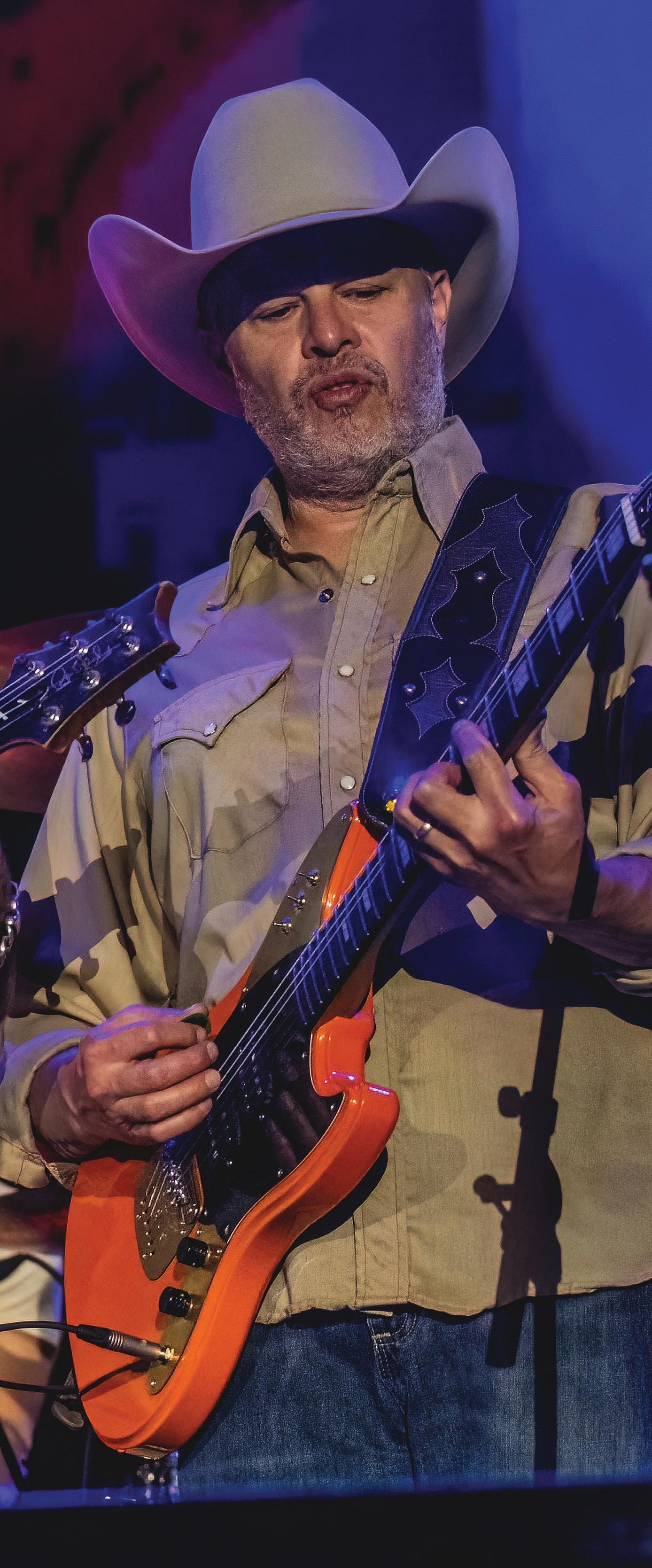
relocate like, ‘Man, we just really enjoyed being back, or we’d never been there before, and that place was great — it’s just got a really good vibe.’”
Williams referenced the economic benefits, and Joyce expanded.
“That’s tourism. Visitor spending is so, so important because that’s the way we start to get ahead,” Joyce said. “That’s why it’s so important that we find ways to do stu like this more often because somebody coming here and spending sales tax money and then going back home somewhere else means that we’re able to do better than just keeping things going. The bump that we see from this event will probably go towards capital projects that we’re not able to fund in our regular budget.”
Visit Stillwater charted the economic impact of The Boys from Oklahoma concert weekend, and the findings were predictably positive:
• Lodging (hotels and short-term rentals) in and around Stillwater saw a major boost in occupancy, demand and total revenue.
• Visitors drove a 14 percent increase in spending, especially in restaurants and retail.
• Visitor tax revenue in April increased 22.2 percent compared to April of 2024.
• Geolocation data shows that concertgoers didn’t just stay near the OSU campus. They moved throughout Stillwater, benefiting a wide range of local businesses.
In the buildup to The Boys from Oklahoma, there was a degree of concern that a large number of people without any ties or a nity to OSU would roll in from out of town, make bad decisions and be wild for a few days, make a mess, then leave the folks who live in Stillwater to clean up.
Clark and Williams said that kind of behavior from visitors was not part of their experience during the week of the concert, and data from local law enforcement supports that.
Over the span of the four-day event, there was a grand total of 11 arrests made. Chief Michael Beckner said OSU Police responded to approximately the same number of calls as it would during a typical weekend during the academic year, which is remarkable given that the population of Stillwater grew by an average of 50,000 people per day during the event.
“To have that many people on campus along with our regular community members, students, sta , and faculty and have no major problems is a testament to our ability to plan and prepare for such an event, Beckner said. “Working with our community partners in the emergency services realm made this event uneventful.”
Clark and Joyce know Stillwater as well as anyone. They both had a perspective on where the weekend ranked in the big picture.
Clark: “I absolutely think it was a special moment in Stillwater history. It was an excellent vibe. It was a beautiful venue, and I just thought it was exceptional. I hope it sets the stage for what we’re capable of and showed a lot of people that, hey, OSU and Stillwater can pull something like this o .”
Joyce: “I’ve been involved in things happening around Stillwater for the last 45 years. I cannot, in that time, recall anything of this magnitude — and not just the number of people, but the impact. People who would not have otherwise been here who walked out of Stillwater at the end and said, ‘That was amazing, right?’”
People loved it — like they REALLY loved it — so naturally, questions came about the possibility of similar events in the future. It’s understood that it would be di cult to recreate the perfect storm of nostalgia and great music that came about with this specific group of artists, but still …
“I would love to see it again, sure.” Williams said. “If we could make it an annual thing, and anything that brings new people to town, because I had people asking me about buying houses here while they were here. They were like, ‘Man, we really want to come back. I think we want to get a place here. Do you know of anything?’ I probably fielded that question at least a dozen times.”
The proof of concept worked, and Joyce spoke with confidence when he talked about how well the infrastructure held up and his perspective on what it could mean for the future.
“There are great assets at OSU and in the community,” Joyce said. “I’m 100 percent on board with whatever else we decide and how to try and put it together.”

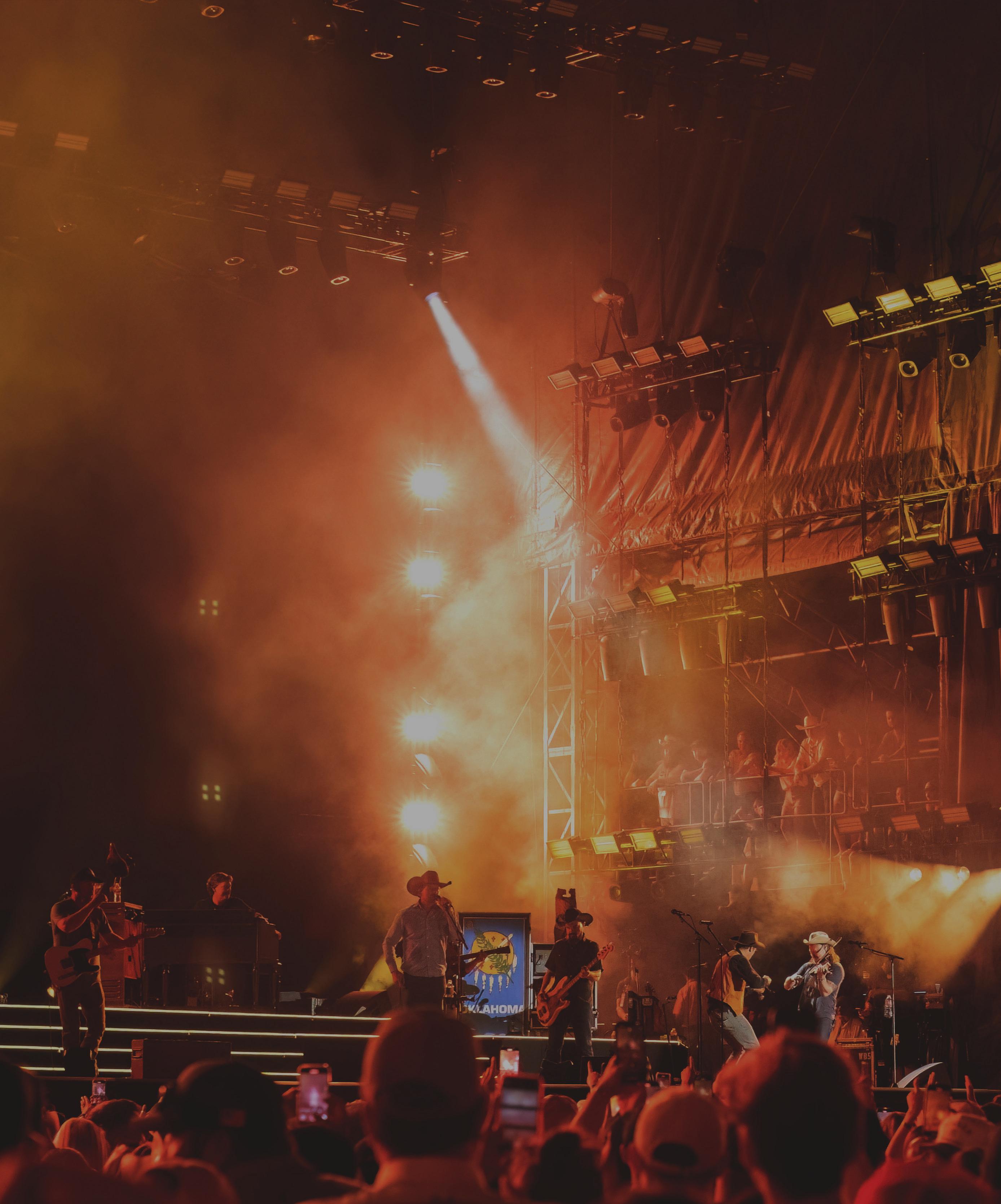


Eddie Sutton Foundation board member Steve Roy pilots a playful posse through "Water Gun Alley" at the 2025 Cowboys vs. Cancer Classic Golf Tournament. Held May 19 at Stillwater Country Club, the event invites children and families impacted by cancer to spend a fun-filled day on the course, joined by a number of OSU celebrities and supporters.
Celebrating its tenth year in 2025, the Cowboys vs. Cancer Classic has raised a total of $1.2 million — including $175,000 this year — to impact the fight against cancer, support those in need, and provide meaningful experiences for those a ected. For more info, visit theeddiesuttonfoundation.com
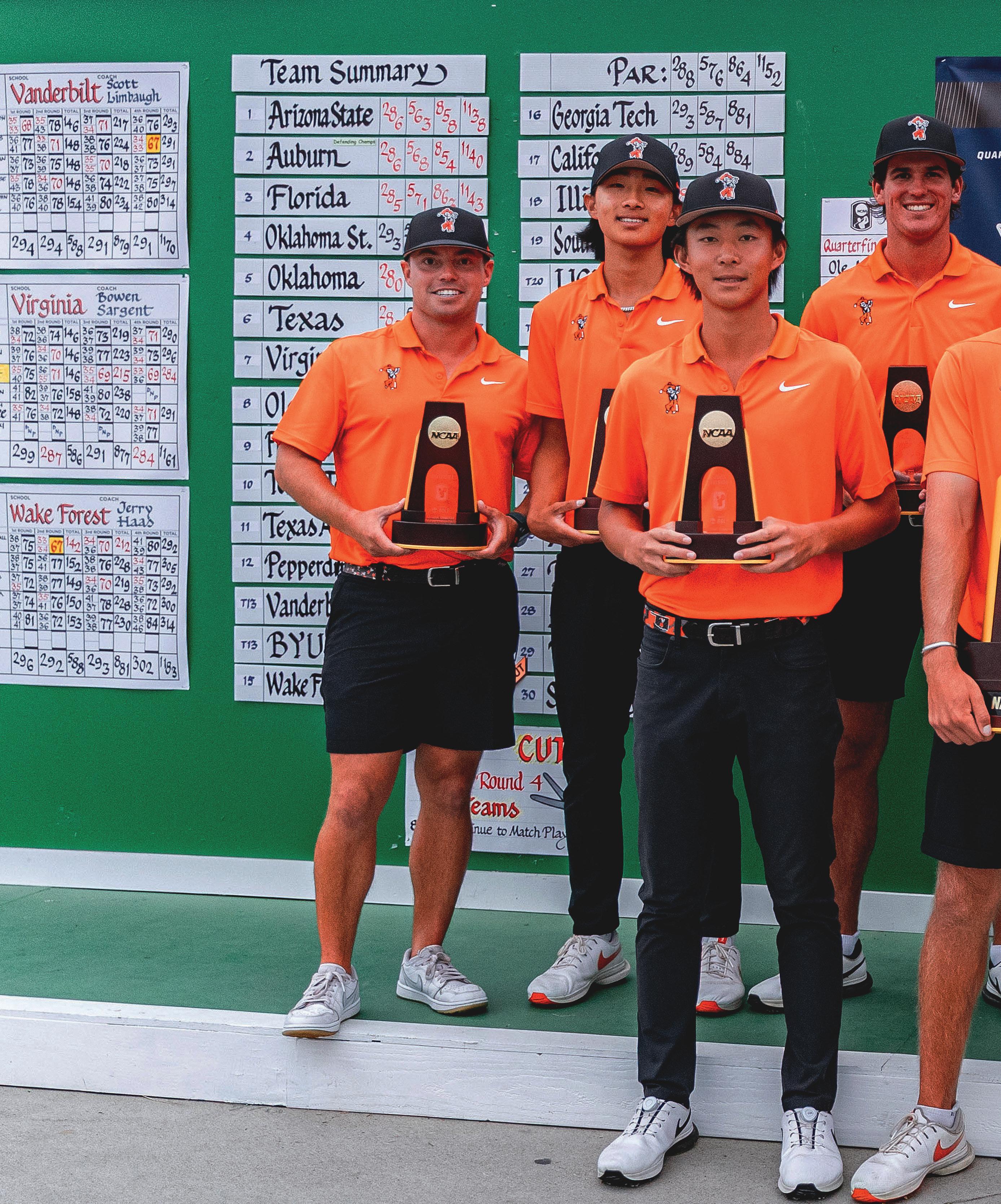


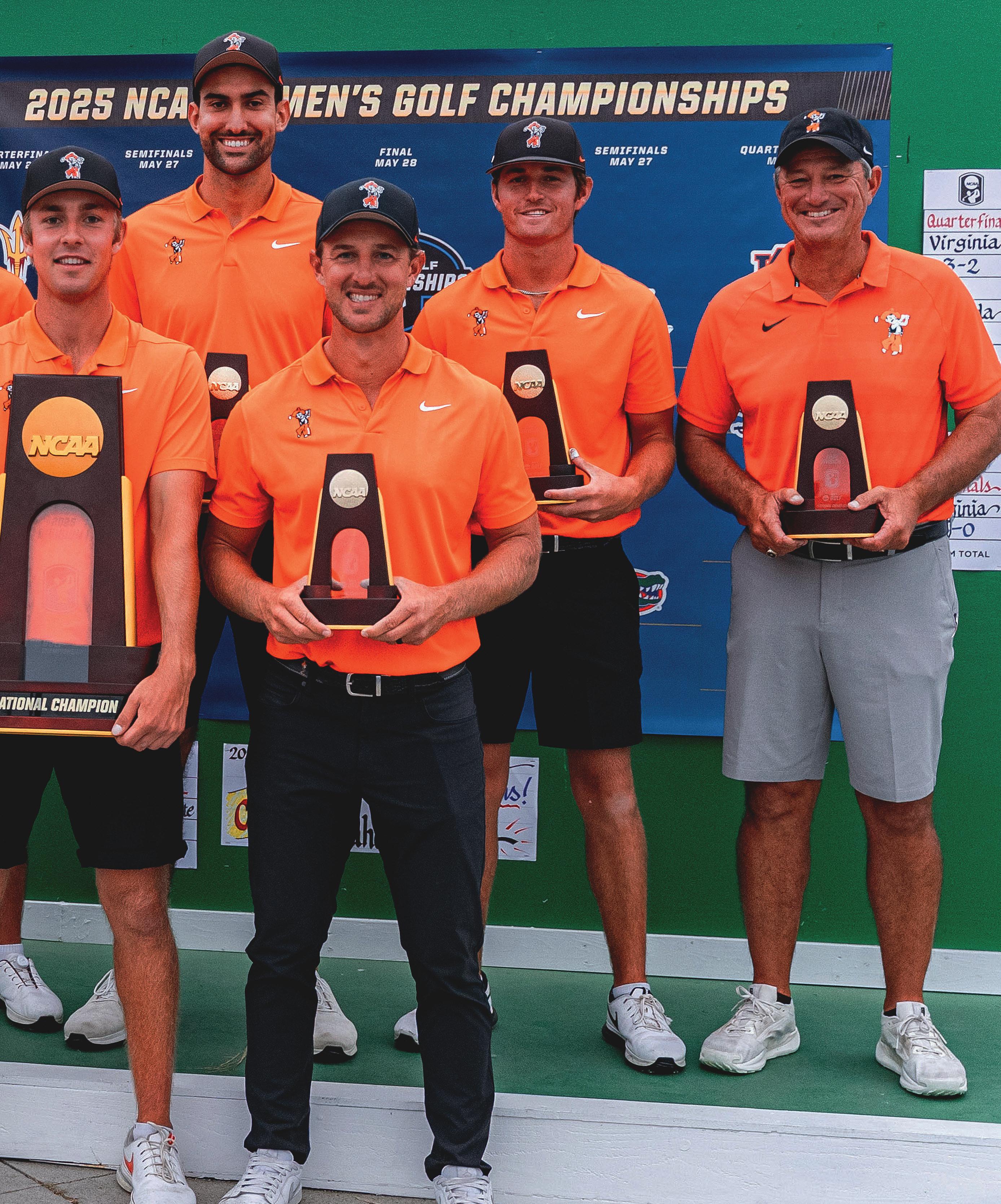
Three decades before Oklahoma State’s men’s golf team delivered the 12th NCAA title in program history, there were the 1995 title-winning Cowboys.
Two teams separated by 30 years but forever connected by three words.
Believe In Destiny.
While that phrase finds itself prominently a xed to a pair of historic championship runs cemented in Cowboy lore, those teams find themselves intertwined in more ways than a catchphrase.
First and foremost, both shared similar dynamics with depth, talent and strong chemistry cemented by friendships on and o the course.
“This team was made up a lot the same way. Ethan (Fang) and Eric (Lee) are really close and play together all the time, like Alan (Bratton) and Chris (Tidland) Preston (Stout) and Gaven (Lane) play together all the time like Kris (Cox) and me,” former Cowboy All-American Trip Kuehne said.
Mix in Leif Westerberg with the former and Filip Fahlberg-Johnsson for the latter, Swedish standouts who both had great relationships across the board, and you have a championship formula.
After beginning his collegiate career at Arizona State, Kuehne added an unfamiliar dynamic to the team, becoming just the second player to transfer into the Cowboy program. An addition that very nearly did not take place.
“I was 99 percent sure I was going to SMU, but decided before I did that, I needed to go to Stillwater just to make sure I am making the right decision, because Coach (Mike) Holder is the best coach,” Kuehne said.
“I was told I would hate Stillwater, but I fell in love with it. Stillwater and Oklahoma State revolved around athletics, and the community rallies around the school and sports, and to be a part of that community means the world to me.”
The 2025 edition of Cowboy golf was the beneficiary of not one, but two players who began their career elsewhere. Initially, Fang, who began his career at the University of California, Berkeley, made the decision to move closer to his hometown of Plano, Texas. Soon thereafter, Lee, his Bear classmate and close friend, would follow.
“The No. 1 message (Bratton) told me was if you want to win a national championship, you have to come to Oklahoma State … and he was right,” Fang said.
If only it was that simple.
There is a science to melding the di erent components of a roster together, which is paramount to a team’s success. Nothing provides a better opportunity for a team to do so than life on the road. Like the 1995 squad, the present-day Cowboys bonded over card games on plane rides throughout the season.
“We started playing spades on the road, and that was a throwback for me to that 1995 team. We used to do that all the time. It was myself and Chris against Trip and Kris, and then we would play on the golf course against each other as well,” Bratton, in his 12th year as OSU’s head coach, said.
With the games on and away from the course maintaining the teams’ competitive edge, both squads piled up wins in bunches as they trended toward the season’s crowning event.
The Cowboys of yesteryear started their campaign with three victories in the fall, including their finale at the Golf World/Palmetto Dunes.
OSU reeled o four consecutive victories to begin the spring season before tallying win No. 8 of the year at the Big Eight Championship at famed Prairie Dunes Country Club in Hutchinson, Kan.
This past season, the Pokes closed the fall slate with their first victory of the season at the Jackson T. Stephens Cup before winning their spring opener in Hawaii at the Amer Ari Intercollegiate. Like their predecessors, the Cowboys then ripped o an impressive winning streak, finishing with four consecutive victories, including the program’s 57th conference title, with their Big 12 title run at historic Southern Hills Country Club in Tulsa.
However, neither campaign would feel complete without hoisting college golf’s ultimate prize.
Rewind to that championship all those years ago and a Cowboy team pursuing its place in history.
Bratton and the Cowboys would stage a comeback reserved for Hollywood scripts. In fact, the victory would lead to a book titled “The Last Putt” being penned years later to document the feat.
A less-than-ideal start for the current Cowboy head coach would lead to a pivotal moment in the tournament’s outcome.
“I was playing terrible that week. I was scraping it around, and I was our No. 1 guy. I definitely was not doing my job,” said Bratton, of his opening two rounds of 75 and 76.

Expecting a stern lecture, Bratton received quite the opposite from head coach Mike Holder to jumpstart his game.

“He showed complete confidence in me. We were sitting by that tree at Ohio State, and I will never forget it. He told me, ‘I know you are going to play well. Two more shots at this course and you are going to be just fine.’ The next day, I played the best round I had ever played, because I was terrible tee-to-green, but I was bogey-free and 3-under.”
Heading into the final round, OSU found itself in third place and three shots out of the top spot on the leaderboard.
Following dinner the night before the final round, the team returned to its hotel where Kuehne was unexpectedly greeted by a pair of notes.
“I got to the room, and there was a note lodged in the door. I opened the door, and there was another note below it,” Kuehne recalled.
“The first note, I can vividly remember it saying, ‘If you don’t believe you can do it, you never will believe in yourself. Believe in destiny.’ The other one simply said, ‘Believe in destiny.’”
The penned encouragement resonated with Kuehne.
“That completely changed my outlook on the whole thing. Fear of failure has always driven me. Losing isn’t an option, we are destined to do this, and we are supposed to win this championship,” Kuehne said.
“Now get yourself in the mindset where you believe, and get your teammates in the mindset where they believe we are going to win this thing, too.”
Who would author those messages?
The answer would not be revealed until several years later when Bratton got one of the most important figures in college golf to admit he was the man behind the mystery.
Long before Golf Channel and social media came along to shed light on the sport there was Golfweek’s Ron Balicki. A man a ectionately referred to as “Wrong Ron” for his uncanny ability to incorrectly predict the NCAA champion each year, Balicki was the lone voice for college golf for many years and the author of those notes.
Revered by everyone in the sport, it was Balicki with whom Rickie Fowler entrusted to tell the world he would be turning professional in 2009. Maybe Wrong Ron left that note because he picked the Cowboys to win that week, or possibly it had to do with his deep admiration and respect for the program.
“He was a special, special guy to me and our team. Like Alan, I thought about him a lot during the week, and when it was over with and we got rid of the Wrong Ron curse, that was obviously something special. What a fantastic human being.
Fortunately, history would tell you OSU’s 2025 championship aspirations were alive and well.
The Cowboys drew Oklahoma in their morning quarterfinal match. With a dominant performance from Stout leading the way, OSU easily handled its Bedlam rival, 3.5-1.5, to advance. The Cowboys took command of the match with Fahlberg-Johnsson claiming the lead match before Fang and Stout delivered the clinching points.
OSU had to quickly hit the reset button for its semifinal match that same afternoon. The Cowboys would face an Ole Miss squad that had spent a good portion of the season as the nation’s top-ranked team and had the individual national champion in Michael La Sasso
Stout continued to show why he is one of the premier talents in the country, steamrolling La Sasso, 5 and 4, before Fahlberg-Johnsson once again delivered on the second extra hole to prevail over Cameron Tankersley and put the Cowboys a point away from a spot in the title match.
It was Lee who would come through in the clutch with a birdie on the first extra hole against Cohen Trolio to keep the Cowboys’ championship dream alive.
An integral part of the sustained success of the Cowboy program comes from the fact you don’t take on the lofty expectations alone. Throughout his tenure, Bratton has made it well known you stand on the shoulders of those who came
before you, and those names displayed in the Karsten trophy hallway are more than just decorations. The pantheon of OSU greats is as beneficial as any resource available.
Among those very resources is the program’s head coach. Bratton recounted the story of the 1995 title run and the three words that spurred the Cowboys to victory. The message sank in with Fang, who took it upon himself to inscribe the initials “B.I.D.” on his ball prior to his final match.
“It kept popping into my head, and I was marking my ball right before I went out to the first tee and I thought it definitely can’t hurt to put ‘Believe In Destiny’ on my ball. I ended up doing it and kept doing what I was doing,” Fang said.
Fang’s simple act is a deeper look into why such a young team was able to achieve at an elite level.
“I am just reminiscing, trying to inspire a little bit. I didn’t know if it would connect with them or not,” Bratton said.
“To find out afterward Ethan had written that on his golf ball, that tells you a little bit about our group. They are listening, and they are coachable, and that stu means something to them. I think that speaks to their character and what a special group it is.”
A special group that is a microcosm of a special program.
“It might not resonate as a player when you are there in that moment, but there will be somewhere through the course of your career or the week at the NCAA Championship that you are going to draw on something said by Lindy Miller, myself,
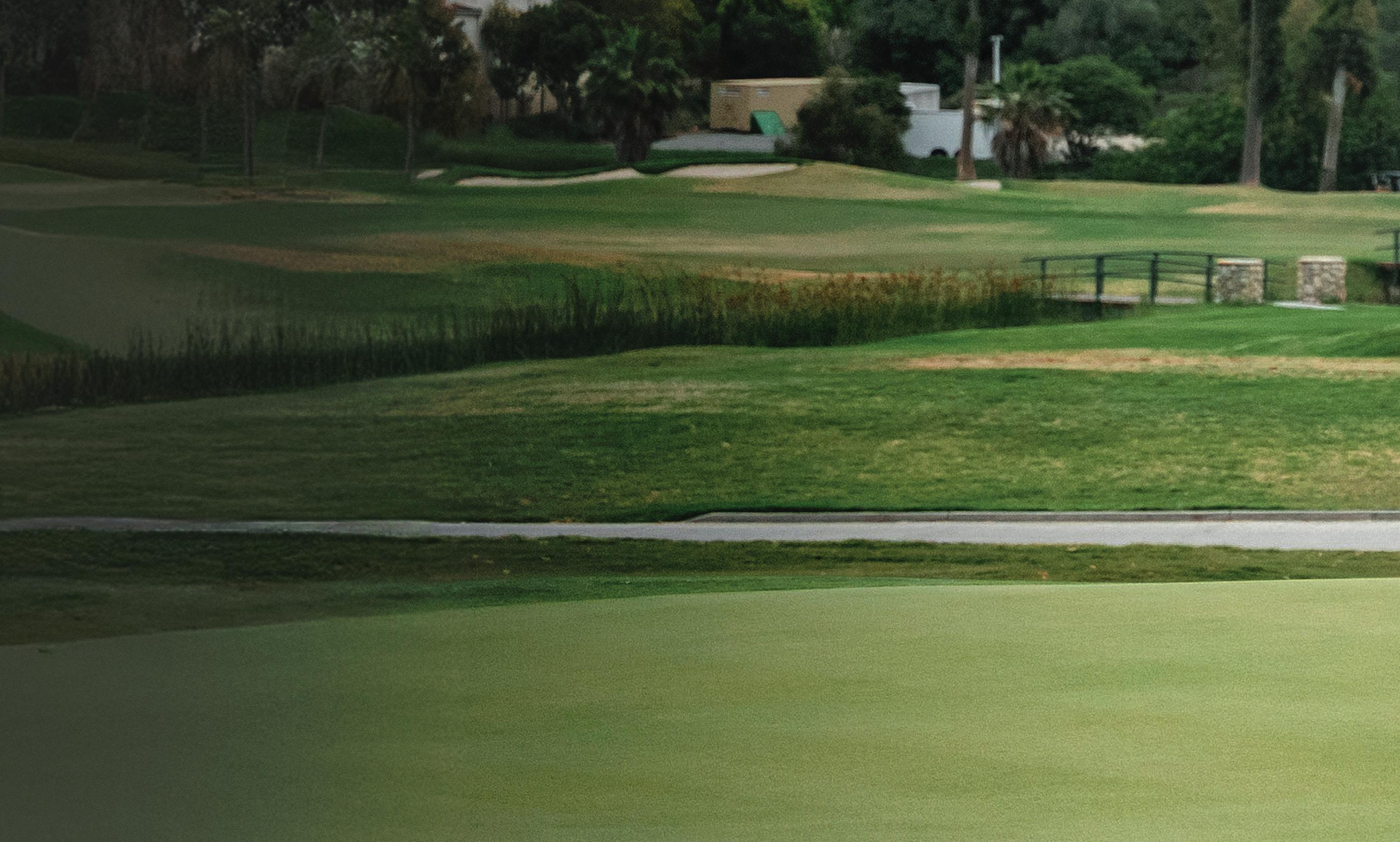

THEY ARE LISTENING, AND THEY ARE COACHABLE, AND THAT STUFF MEANS SOMETHING TO THEM. I THINK THAT SPEAKS TO THEIR CHARACTER AND WHAT A SPECIAL GROUP IT IS.” — ALAN BRATTON
Charles Howell or some other great player who has been at Oklahoma State,” Kuehne said.
“It helps when you look in the crowd and all of the sudden there is Bob Tway, there is David Edwards, there is Scott Verplank, there is Rickie Fowler, there is Viktor Hovland or Matthew Wol , just go down the list.”
True to form, as the Cowboys navigated the week, messages rolled in from the likes of PGA Tour standouts Fowler, Hovland, Austin Eckroat and Sam Stevens, as well as those 1995 Cowboys complete with Tidland sending a photo of his hand wearing his championship ring from that epic victory 30 years prior.
Now, with the Cowboys on the cusp of another national championship, that support system was in a full-on embrace with Lane, who had come out on the short end of both of his matches leading up to the final.
“Trent Leon was sending messages to Gaven to encourage him because Trent was drawing back on 2006 when he didn’t count a shot until the final round. He went out and played great and helped lead us to the championship. He and Gaven are friends, so there were messages there, and he kept reminding him he had to believe,” Bratton said.
Kuehne was among several former players who made the trek to the west coast to support their program and would serve as much more than a casual spectator.
Arriving on property thinking he would walk with Fang or Lee, Kuehne received di erent marching orders from Bratton — a familiar face was exactly what the Cowboy head coach thought Lane needed.
And he was right.
The championship match between the Cowboys and a talented Virginia team developed into exactly what a championship match should be.
Once again, Fahlberg-Johnsson set the tone in the leado match, with the freshman taking down Maxi Puregger, 3 and 1, to finish 3-0 on the week.
Virginia answered with an impressive answer of its own with All-American Ben James taking down Stout.
With each team two points away from victory, momentum leaned the way of the Cavaliers. Bryan Lee held a 2-up lead with eight to play against Fang, while Paul Chang was in control of his match with Lane, maintaining a 2-up advantage through seven.
And then match momentum swings happened.
Fang would win three holes in a row to quickly wrestle momentum and the lead away. Lane had also rallied,

winning consecutive holes to pull even before delivering a crushing blow with a 30-foot birdie putt from o the green at the 11th to remain tied when it appeared Chang was set to regain control. Instead, Lane would go on to win the next four holes to close his pivotal match.
“Good, bad or indi erent, I was there for him and anything he needed within what the rules allowed me to do to help him win his match and us win the championship,” Kuehne said. “That is one of the prouder moments of my life — to be able to hug his neck when he won his match and tell him how proud I was of him. It meant a lot to me.”
Like the day before against the Rebels, Lee found himself in position to provide the knockout blow for the Cowboys in his back-and-forth battle with Josh Duangmanee. The two players saw their match tied on three di erent occasions, and neither player led by more than one before Lee seemingly took control with a 2-up lead through 12 holes. However, Duangmanee won the next two holes, and the match was once again knotted with four holes remaining.
Lee would bury a 25-foot birdie putt on the penultimate hole to head to the closing 18th with a shot to put OSU in the history books. And what a shot it turned out to be.
After his 3-wood approach at the par 5 went wayward to the right, a tricky chip shot remained — one that would have to traverse rough, a cart path and a runo area before it reached the green. After Lee’s ball found the green and trundled toward the hole before stopping five feet away, destiny was once again on the side of the Cowboys.
With Lee providing the clinching point, a familiar feeling of euphoria reserved for champions once again washed over Bratton, Kuehne and a special group of Cowboys.
“You look at the history of the program, and it has been awesome. They are one of only 12 teams to ever do it. They’re legendary, and they have an opportunity to do things that Oklahoma State hasn’t done. They can become immortal,” Kuehne said.
Destiny fulfilled.



Cowboy head coach Mike Gundy addresses his team following a fall practice in preparation for the Aug. 28 opener versus UT Martin at Boone Pickens Stadium. The 2025 schedule features seven home games, including turnpike rival Tulsa, plus Big 12 foes Baylor, Houston, Cincinnati (Homecoming), Kansas State and Iowa State. For ticket and schedule information, visit okstate.com/tickets











The Big 12 has always been a little — let’s say “quirky.”
From the formation of the original 12 schools in the 1990s, a marriage which seemed to have happened despite the objections of the actual wedding parties, to not just the unlikely and continued existence, but growth, of the league in the 2020s.
The conference survived the past several years of realignment chaos in part due to the demise of the Pac-12 Conference, a league steeped in history with associations dating back over a century. It was the Pac-12 that made at least one attempt (and really more) to strip the Big 12 of its most valuable properties. Many would call it a semi-major upset that the Big 12 has not only remained stable, but expanded and strengthened, while the Pac-12 is rebuilding from the ground up.
When it comes to television, the Big 12 once again remains unique when compared to its power conference brethren: perhaps unique and ahead of the curve. The Big 12 is the only conference with television partnerships with both ESPN and FOX, the two biggest content rivals in the space of college athletics. The conference is also the only power league without its own linear television network, but was among the early adopters of streaming as part of its ESPN partnership. Other conferences have since followed the streaming path, along with pretty much the rest of the world.
When the Big 12 announced it was heading to streaming for its third-tier television home, the number of ESPN+ subscribers was approximately 5.5 million. The most recent numbers available show that count now over 24 million. The Big 12 can’t claim to be responsible for all that growth, but then again, why can’t it?
“Spreading Big 12 contests across multiple TV and streaming platforms is a deliberate strategy to grow audience reach, strengthen brand equity and future-proof the conference’s media footprint,” said Kauri Black, the league’s associate vice president for broadcast and emerging platforms. “By running parallel paths, leveraging both traditional linear partners and emerging digital platforms, the Big 12 meets fans where they consume content, diversifies potential commercial opportunities, and gathers meaningful data to inform future programming.”
Since the announced streaming partnership between the conference and ESPN in 2019, OSU and Big 12 fans have grown accustomed to games being streamed from every corner of every league campus, and the rest of the country seems to have noticed, according to Black.
“This approach aligns with shifting consumer behavior, as highlighted by the Nielsen’s May 2025 The Gauge report, which showed streaming viewership surpassing traditional TV for the first time,” he said. “It also supports the Big 12’s






broader goal to be the most culturally relevant conference and remain top-of-mind with younger audiences, particularly within the 18 to 34 demographic.”
In this new academic year, the Big 12 takes another step with its latest television deal, which broadens the Big 12 horizons further and will feature conference events in new spaces and with even more national options and partners.
The first change viewers will notice in 2025 is that Big 12 football games will appear on more than just ESPN and FOX. The conference will also be televised on TNT (and streamed on HBO MAX), a “cable” network that was in the college football business in the 1980s and 1990s along with its sister station, TBS. Since 2011, TNT has been airing NCAA men’s basketball tournament games in a sub-licensing agreement with CBS, and it has had a long history with the NBA.
Along with Big 12 football games, TNT will also televise two College Football Playo games in December, growing in prominence and relevance to the college football fan.
“Our partnership with WBD (Warner Brothers Discovery), the parent company of TNT, unlocks strategic access to Bleacher Report and House of Highlights, platforms with unmatched reach among Gen Z (1997-2012) and Gen Alpha (2010-2024),” Black said. “These digital-first audiences expect content that’s fast, mobile, and culturally relevant. This positions the Big 12 at the center of where influence is built and future consumers are won.”
The WBD partnership, therefore, also strikes at the heart of potential future students for every Big 12 campus. The move comes at a time when universities across the country are bracing for the enrollment cli , which has been hovering on the horizon since 2007 when American birthrates began to drop and have never fully recovered.
Despite the new and expanded partnerships, the bulk of Big 12 football will still be found on FOX and the ESPN family of networks, the two-headed monster which remains the hub of college football with their live events and shoulder programming such as College GameDay and Big Noon Kicko .
“Managing the execution and partnerships with ESPN and FOX requires constant alignment across programming, production and promotion,” according to Black. “It’s not just about scheduling games or working through the draft process (weekly game selections), it’s about balancing two distinct network strategies while ensuring the Big 12’s top matchups land in the most visible, high-impact windows.
“SPREADING BIG 12 CONTESTS ACROSS MULTIPLE TV AND STREAMING PLATFORMS IS A DELIBERATE STRATEGY TO GROW AUDIENCE REACH, STRENGTHEN BRAND EQUITY AND FUTURE-PROOF THE CONFERENCE’S MEDIA FOOTPRINT.”
— KAURI BLACK, BIG 12 ASSOCIATE VP FOR BROADCAST AND EMERGING PLATFORMS

“With FOX holding rights to the Big Ten and ESPN controlling the SEC (and to a lesser extent the ACC), we must be proactive and strategic to ensure the Big 12 remains prioritized.”
Over the past several years, CBS (the long-time home of March Madness) has televised approximately six Big 12 men’s basketball regular-season games. The network and Big 12 are expanding that partnership, raising the number to 26 games spread across CBS platforms, which include CBS, Paramount+ as well as the CBS Sports Network
In the college football TV landscape, CBS games pack plenty of punch, but trail ESPN and FOX in influence due to the sheer number of games carried by the latter two. However, there is a mammoth upside for the Big 12 in further partnering with the network that has been the home of March Madness since 1982
The marriage of CBS and the Big 12 has the makings of a dream couple. The Big 12 has produced six Final Four teams
over the last nine tournaments, not including Houston’s trip in 2021 as a member of the American Athletic Conference. Four of the last six tournaments have included a Big 12 team in the national championship game with two titles won by the league.
Also new this year, look for Big 12 basketball to make its way to the NBC streaming platform Peacock in a sub-licensing deal with CBS. Peacock’s college sports portfolio already includes Big Ten football and basketball and is the home of the NFL’s Sunday Night Football game. This agreement, in essence, puts the Big 12 Conference in business with all four major “broadcast” networks, plus ESPN.
“The addition of sublicenses partners like TNT Sports, NBC with Peacock and CBS and CBS Sports Network enhances scheduling flexibility, creating more inventory for high-quality matchups that would otherwise default to ESPN+ while expanding opportunities for storytelling, access, and innovation around the Big 12 brand,” Black said.
College athletics and television have gone steady for many years, but they have also consistently agreed to see other people.
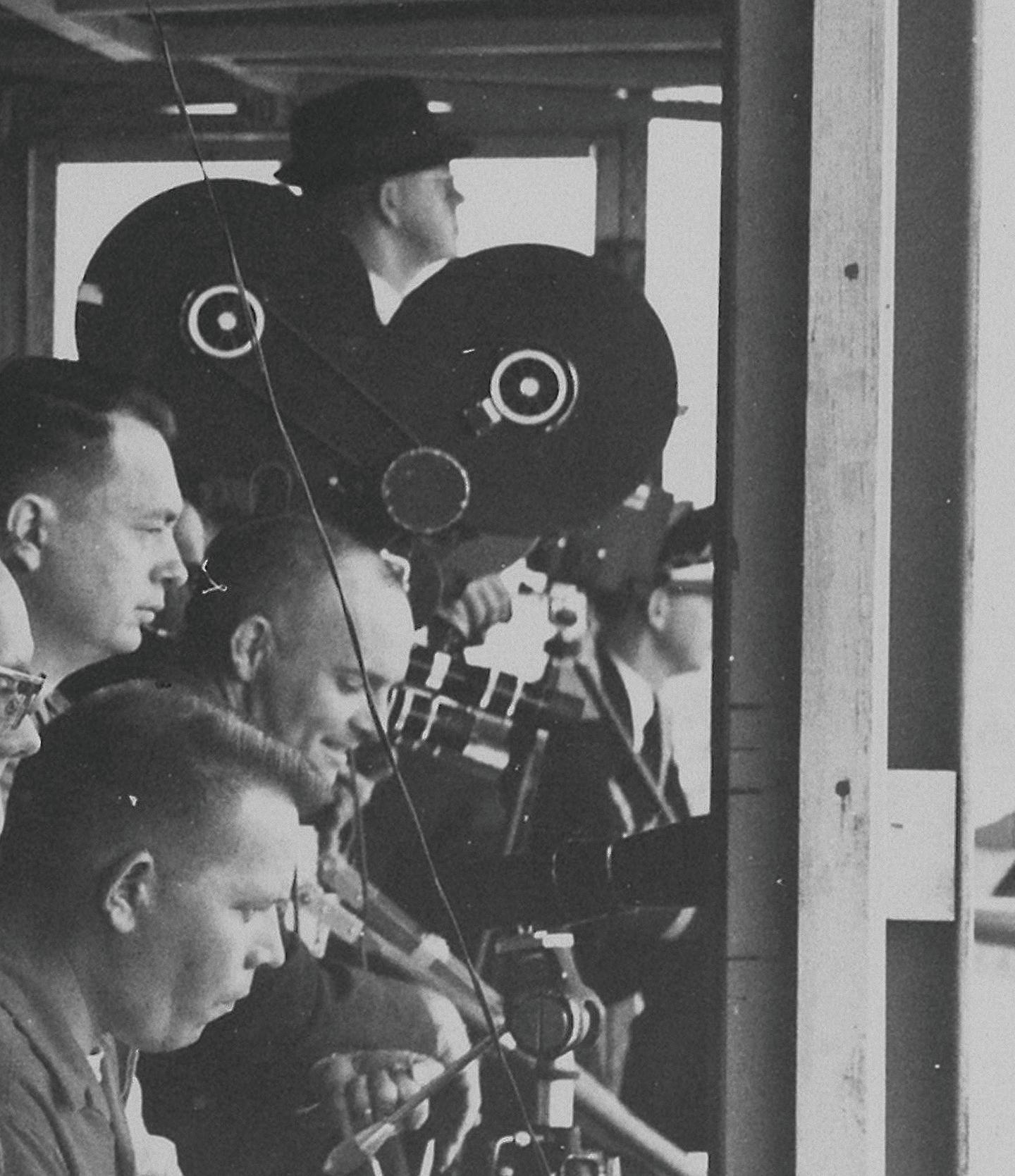
As they say in the modern vernacular … it’s complicated.
The role of television with college sports, and college football in particular, has only done one thing consistently: change.
From the first televised college football game (Fordham vs. Waynesburg in 1939), to the 1984 Supreme Court ruling giving schools the right to sell their own games (pushing the NCAA aside), to the formation of the College Football Association (CFA) which collectively negotiated TV deals in the 1980s, relationships with live television and college athletics have continued to evolve.
Somewhere along the line, the folks on campus went from actively trying to keep college football and basketball o the air, or severely limiting broadcast opportunities, in an e ort to protect ticket sales, to courting television partners and the addicting rights fees they paid leagues.
The change in perspective eventually led to realignment as schools (and leagues) began shopping for the best rights deals (more money).
came in 1958 at the University of Denver in what was a regional NBC broadcast. Later that same year, the Cowboys made their first national TV appearance when ABC carried the Pokes’ Bluegrass Bowl win over Florida State. In the booth calling the action was a young Howard Cosell.
Throughout the entire decades of the 1960s and the 1970s, Oklahoma State made a total of just seven television appearances with most of the country just having access to the one ABC Saturday afternoon game. Those games were then followed by the old Prudential College Football Scoreboard show. Each week, due to afternoon kicks, most of the final scores only involved east coast schools. It was a way for Oklahomans to be introduced (and reintroduced, and further introduced) to the football programs of Holy Cross, Slippery Rock and the Ivy League.
After the 1984 court case, college football slowly began to show up — everywhere. In the 1980s, OSU’s TV appearances jumped to 28. However, there were still chinks in coverage, how else to explain the historic season of Barry Sanders reaching a national TV audience just twice in 1988 — and one of those was in the Holiday Bowl, after he had won the Heisman Trophy.
As recently as the early 2000s, Oklahoma State and its Big 12 siblings had their share of national appearances, but plenty of games were also on localized carriers such as Fox Sports Southwest, Versus, FOX Sports Network, ESPN Regional, FSN Plus and FCS (Fox College Sports).
In 2011, as the Cowboys were making their Big 12 championship run and narrowly missing a berth in the national championship game, one Big 12 contest (vs. Kansas) was not televised anywhere. Perhaps that was a wise decision since OSU led 56-7 at halftime.
In 2012, every Cowboy game was available somewhere, and since 2019, every game has been on national television or available via streaming, which usually accounts for one football game per season.
The streaming revolution has had an even bigger impact away from football. It is now a cold slap in the face to seek but not find live video of your favorite team or event, regardless of the sport. The lone exceptions might be golf and cross country. However, even those sports, which have more acreage than all the rest put together, have ventured into the streaming and television space — especially during post season.
OSU’s first documented football television appearance
“Under the previous TV deal, Big 12 schools were required to produce a minimum of 50 live regular-season competitions per year (for ESPN+), excluding football,” Black said. “This total had to include all men’s basketball exhibition and regular-season games NOW AIRING ON ...
not selected as part of ESPN’s overall contractual commitment, while ESPN produced a majority of the remaining men’s basketball games and provided a campus production stipend.
“Under the new model, institutions must now produce all home games not selected for linear or digital TV.”
The new agreement o cially means every event (well, 98 percent, at least) on the Oklahoma State campus will be available somewhere. It might signify a change or new burden on some schools, but it doesn’t really have an impact in Stillwater.
“In anticipation of this new agreement, we have been producing every home event for ESPN+ over each of the past two years,” said C.J. Lickert, who oversees OSU’s Orange Power Studios, which originates all of Oklahoma State’s live content. “We have been averaging around 80 events a year during that time. That number has risen steadily over the years.”
There are still some rough edges to smooth out, much like there were during the evolution of football on television. For Orange Power Studios to cost-e ectively stream live events, fiber must connect each athletic facility to the two control rooms in the west endzone of Boone Pickens Stadium. Currently, OSU does not have fiber connections to the equestrian, golf or cross country facilities. Those home events can only be streamed live with outside contract help on hand, adding dramatically to the costs. As a result, their appearances on ESPN+ are somewhat sporadic or sometimes streamed on a delayed basis.
There are also some scheduling conflicts. For instance, during the spring seasons, if OSU baseball and softball games are being played simultaneously, not to mention a baseball video board that requires its own production, something gets squeezed. Three live productions and two control rooms just aren’t a perfect match.
“We sometimes make compromises, but usually just a couple of times per year,” Lickert said. “We can use the video board production for our baseball live stream, if needed, and still have dedicated announcers. It’s not as high-end of a production because it is geared toward the fans in attendance, and we take some hits graphically on what we can do on the stream, but it allows us to get all of our events to the fans.”
therefore the home team’s conference, controls television rights each game.) The Friday night Tulsa game on Sept. 20 will be on ESPN.
Granted, having multiple television (or streaming) homes for Cowboy and Cowgirl contests now requires a little homework to make sure your screen is at the right place at the right time. The flip side is that football and men’s and women’s basketball are not the only contests available. Cowgirl Soccer, the baseball Cowboys, the softball Cowgirls, and OSU Wrestling all have their home events televised or streamed as part of the Big 12 agreements.
It is an orange and black bu et of viewing options all coming to a screen near you.
All of these carriers may seem part of the Big 12 quirkiness. But if the past is any indication, the Big 12 is likely ahead of the curve
At this writing, Cowboy Football knows the video home of its non-conference schedule. The season opener on Aug. 28 vs. Tennessee-Martin will be on ESPN+. The Oklahoma StateOregon game in week two will be played on CBS as part of the Big Ten television package. (The home team, and



The Oklahoma State soccer squad works out in the early evening shadow of Neal Patterson Stadium during its first o cial practice of the fall.
Ranked in the preseason Top 25, head coach Colin Carmichael's Cowgirls are coming o a 14-5-3 season (6-3-2 Big 12), which included a return to the NCAA Championship. The 2025 squad is led by All-Big 12 performers Gracie Bindbeutel, Xcaret Pineda and Laudan Wilson among seven returning starters from last season.
OSU opens Big 12 play at home against Kansas on Sept. 18. During a three-match stretch in October, the Cowgirls host BYU, Kansas State and UCF, with Baylor coming to Stillwater for the regular season finale on Oct. 30. For ticket and schedule info, visit okstate.com/tickets.






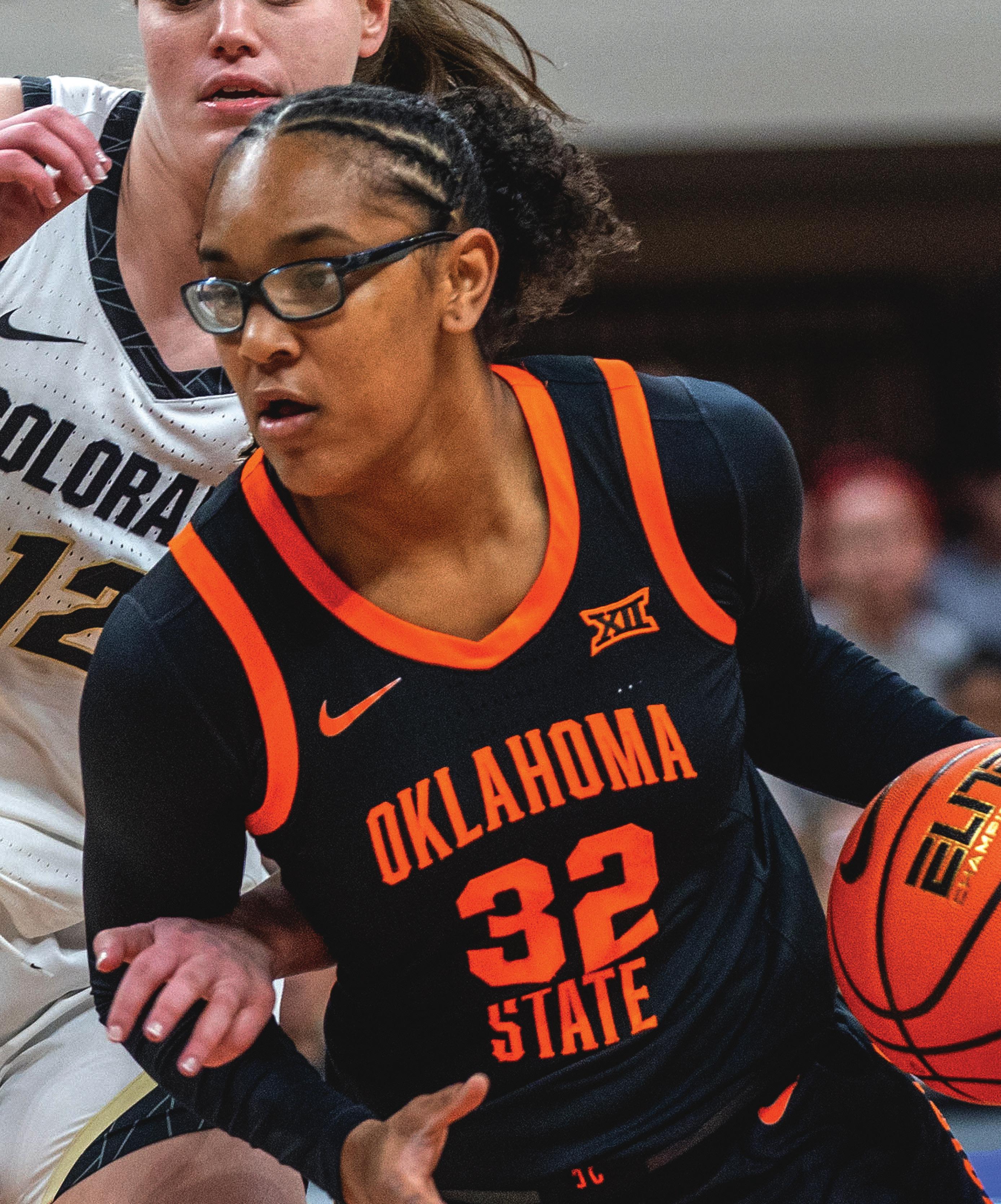
Before Stailee Heard emerged as Oklahoma State’s leading scorer, she grew up like most children, with a list of rules.
Chief among them being she could never say one word.
“In our house, growing up, you couldn’t use the C-word her father, Tony Heard, said. “And that’s ‘can’t that. You know you don’t use that word around this house, because you can do anything that you put your mind to, and you work hard at it.”
Stailee certainly backed that up with her play on the court last season, which powered the Cowgirls to a record-setting 17-1 mark at home, the third-best win total in program history (25), plus a return to the NCAA Tournament
She finished the season as an honorable mention All-American and was a first-team selection on both the Big 12’s regular-season and conference tournament teams after finishing 11th in the league in points per game (16.8) and fourth in rebounding (9.4). The sophomore even set school and conference records when she made 13 consecutive 3-pointers
For context, the all-time NCAA record is 14.
It sounded nice, but none of that really had any impact on Stailee until she heard that she knocked down a team-high 41.3 percent of her 3-point shots as a sophomore.
“Wow,” Stailee said, momentarily rendered speechless.
“That’s crazy to hear. I mean, that just shows if you put the work in you’ll get better. It was long, hard days, but it showed up. It actually feels great.”

As a high school junior, Stailee averaged 19.4 points, 9.2 rebounds, 3.7 assists and 2.2 steals per game at Sapulpa, but some college coaches doubted she had what it took to succeed at the next level.
“She didn’t get recruited a lot of places because they said she didn’t shoot, she couldn’t shoot threes,” her mother, Lila Osceola-Heard, said.
Her father said multiple schools questioned his daughter’s ability to shoot beyond the arc, but added there was one unnamed school in particular whose criticism stood out.
As a freshman at OSU, Stailee knocked down a respectable 35.6 percent of her 3-point attempts to finish second on the team. A good start, but she only attempted 87 threes, a full 53 shots behind the third-most active 3-point shooter on the Cowgirls’ roster.
Ahead of her sophomore season, Stailee and OSU head coach Jacie Hoyt agreed that improving her 3-point shooting needed to be a priority.
“
SHE HAS JUST A REFUSE-TO-LOSE MENTALITY THAT OUR KIDS FED OFF."
— JACIE HOYT
“We worked on it every day, before and after practice, like during practice, and she (Hoyt) was really on me about it,” Stailee said.
As a sophomore, she attempted 143 three-pointers while improving her accuracy from deep by almost six percent.
“That was probably an area of her game that most people would say was a weakness,” Hoyt said. “And the cool thing is, she found a way to turn it into a strength.”
When asked if Stailee’s improvement changed the game plan for OSU coaches midseason last year, Hoyt started laughing and added, “1,000 percent.”
Despite nearly breaking an NCAA record, the OSU coach said improving Stailee’s 3-point shooting remains one of her biggest priorities this o season as well. Considering Stailee finished with 12 double-doubles, second among Big 12 players and 45th in the nation, she deserves to enter her junior season as a household name within the conference’s footprint at the very least.
Just don’t expect any of that to change Stailee’s process.
“I feel like there’s just always more to get better at,” Stailee said. “Like I made it past sophomore season. That’s … whatever. But getting to the next level — that could be part of arriving, quote, unquote. Or going to play overseas, that’s the big jump where I want to be.

“And those stats are just helping me get to that place, get there. … I don’t feel like I’ve arrived (yet).”
Those closest to her are well aware that Stailee can be her own worst critic. She will often take it upon herself to get in extra shots if she feels she’s struggled, even if the team still won. Those standards don’t fade when she competes in other activities, like say a recreational volleyball league for adults.
“We lost last night (for the first time in almost three seasons),” Osceola-Heard said of the volleyball league the family competes in annually. “And we haven’t lost ever … I was like, ‘What was the score?’ And somebody said, 21 to 19. I was like, ‘Oh man, we were right there.’ Stailee was like, ‘We shouldn’t have lost.’ She was so mad. And yes, I’m mad, but I mean, we never practice.’”
Back in June, her mother laughed at Stailee’s intense reaction to the loss the day after, but she knows that both her daughters inherited that competitive spirit from their parents. Last season for the Cowgirls, that attitude proved to be a di erence maker when the team broke 14 program records.
“Stailee was a huge part in that,” Hoyt said. “She was our main leader, in that she’s the one who really took charge and kind of led the way for everyone. She has just a refuse-to-lose mentality that our kids fed o .”
Stailee’s on-court dominance did not surprise Hoyt. Stailee had already earned her coach’s respect before the season even began.
“I would say the thing I’m most proud of is that she’s stuck with herself, and she’s stuck with this program the year before, when things weren’t so good,” Hoyt said. “And I think that that shows more character than anything in today’s climate … She took ownership, and she said, ‘We’re going to get this thing straightened out.’ And then she put the team on her back to do that.”
As a freshman, Stailee found herself thrown into the deep end as one of four Cowgirls who played more than 1,000 minutes as injuries dramatically limited OSU’s roster. For context, last season Stailee was one of only two Cowgirls to play 1,000-plus minutes despite the team playing two additional games in the postseason.
So it’s no huge surprise that OSU limped to a 14-16 record that included a 7-11 finish in conference play in 2023.
“My freshman year, it was terrible,” Stailee said. “It was dreadful. I didn’t want to be here. I didn’t want to play basketball.”
Hoyt said her bond with Stailee is built on the fact that those two, perhaps far more than almost anyone else, “just hate to lose more than we love to win.” So the OSU coach understands completely how tough it was for Stailee as a freshman.

“They represent balance. They balance each other out. They have a balanced life.”
— LILA OSCEOLA-HEARD
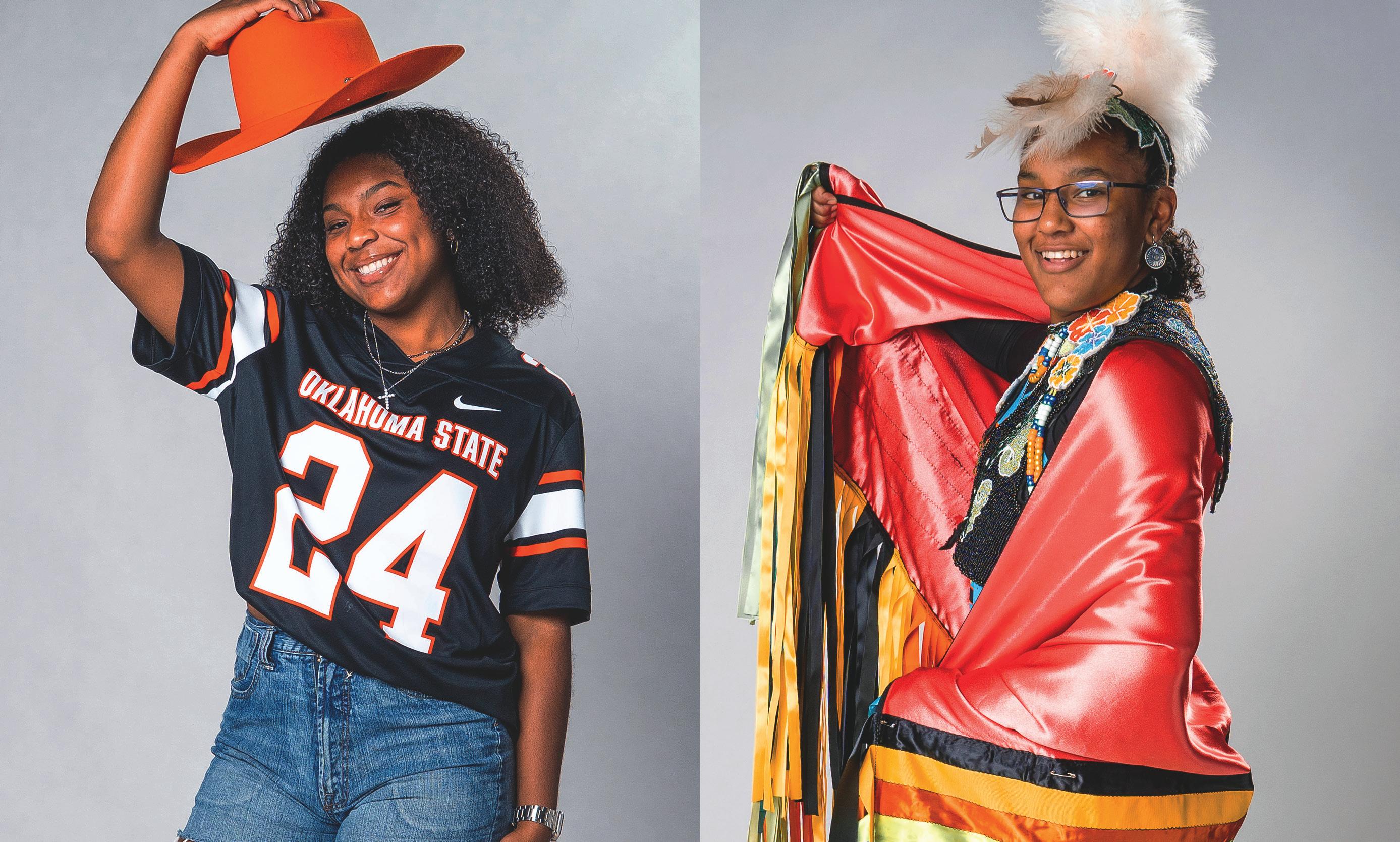
“We probably both dreaded going to practice (her freshman season) and it just, it wasn’t the atmosphere that either one of us had envisioned or wanted,” Hoyt said. “But sometimes you have to go through things like that to make you appreciate when things are going the way that you want them to go.”
Reminiscing on the first-round NCAA exit in 2024, Stailee took an optimistic view of things for a change. Instead of focusing on the disappointment of not advancing further, she took pride in what the Cowgirls accomplished.
“I gained that (fun) back, and I can truly thank Jacie for that,” Stailee said. “She brought in these girls, the girls we needed around me, around (former teammate) Anna Gret (Asi). She’s doing the same thing this year. She’s forming girls around the returners and just building a better, stronger foundation.”
That future will include two Heards on the court this season as Stailee’s younger sister, Tyla, joined the program during the o season after spending her first year at Oral Roberts.
“It’s truly a blessing,” Stailee said. “We’ve played together our whole life, and then we had those couple of years to play without each other. I think we make each other better. She makes me better at things I don’t do much. And I make her better on things she doesn’t do very well.”
Although the entire Heard family is thrilled that the sisters will reunite on the court, the credit belongs to the Cowgirl head coach.
“The biggest thing when it comes to the Heards as a family is just understanding what you’re going to get in terms of them being great competitors,” Hoyt said. “They’re very, very blue collar, they’re not going to be outworked, and they’re incredibly tough. And those are three of the most important things that we look for in kids when we evaluate and recruit.”
Early in the summer, Hoyt began to see Stailee take her leadership to the next level. The Oklahoma State coach expected some of that, after all, Stailee is an upperclassman now. However, Hoyt doesn’t think it is a coincidence that Tyla joined the program around the same time her sister took even greater ownership of the program.
“I think that she feels a great responsibility to lead her sister in the best way, in the best direction possible,” Hoyt said.
Tyla didn’t hop into the portal with any expectations of ending up in Stillwater. When she decided to leave Oral Roberts, she spoke with several schools seriously before hearing anything from Oklahoma State at all. But when the Cowgirls finally reached out, the opportunity to reunite the Heard sisters after the duo helped Sapulpa win two state titles in a three-year window was simply too good to pass up.
“Because she (Stailee) makes me better on and o the court,” Tyla said. “And I would get to be with my best friend every day. So how can you turn that down?”
Tyla said her older sister pushes her to be more aggressive on the court, which is something she needs to work on at the collegiate level, particularly when it comes to scoring.
“I want to be great in the way that she got there,” Tyla said. “She teaches me how to work hard. She teaches me how to be a good leader, a better teammate o the court. She’s a little more organized than me.”
The sisters will live together this upcoming season, which means Stailee will likely find herself keeping up with two schedules for her more organizationally challenged sister. In exchange, Tyla will do the cooking for the house, which thrills Stailee. The younger sister also plans to drag Stailee out of the house more often.
“Tyla is the more outgoing one,” their mother said. “Stailee is going to sit in a room or go back to the house and mow. She’s the homebody. They balance each other out, because Tyla is going to get her out there and make her do things like what I tell her (Stailee) every year — meet someone new. Every year, I tell her meet someone outside of basketball. Has she? No. The first day Tyla had her orientation, she met four people.”
It’s not unheard of for the sisters to get stopped for pictures with fans, especially when they’re around their old stomping grounds.
“They’re kind of bigger influences than they realize. They can influence a lot of little girls’ lives just by being themselves and doing what they love to do,” Tony Heard said.
Of course, their platform doesn’t stop there. Stailee and Tyla are proud to be enrolled citizens of the Seneca-Cayuga Nation and also descend from the Muscogee (Creek), Seminole, Wyandotte and Sac and Fox tribes. They both hope their success on the basketball court will continue to inspire other Native American kids to aim higher in all aspects of life.
“Most Native kids think they can’t make it to this level because they’re Native,” Stailee said.
“Can’t” wasn’t allowed in the Heard household, of course. But the sisters still grew up aware of the doubts plaguing their peers.
“They would be like, ‘That’s so cool (referring to the Heards’ basketball dreams), we could never,’” Tyla said. “Like, yes, you could. And even us saying, ‘Yes you can, you can do whatever you put your mind to’, it is like they were taken aback by it.”
Over the past summer, the sisters led a basketball camp sponsored by the Seneca-Cayuga tribe.
“That was really fun, just to influence kids that have been watching us,” Stailee said. “And they get to hear from our point of view. We talk to them about balance, how it is important for your wellness and your mental health. And it’s not all about basketball. You have to have a balanced life, or it’s just going to be stressful and hard.”
The camp was called Native Balance
“The goal when we introduced it to the tribe was we want it to be a balance,” Osceola-Heard said. “Because that’s what the girls are about. They represent balance. They balance each other out. They have a balanced life. They just don’t throw themselves into basketball. They do their culture side.”
Stailee said taking time to attend stomp dances and powwows remains a priority for her despite the commitment of being a Division I athlete.
“I think about a whole community behind me through my ups and downs,” Tyla added. “If I fail, if I succeed, they’re going to be there no matter what. And that’s really comforting to know. As someone who’s gone through both: I’ve had good times in my life, bad times in my life.
“I can always go back. No matter what’s happening, no matter who I’m still close with, no matter if we haven’t seen each other in three years. I’m going to come to a powwow and we’re going to dance together.”
Once again teamed up on the court, there’s a good chance the sisters will be dancing together in March




Cowboy cornerback JK Johnson celebrates an interception in fall camp with defensive quality control coach Dean Marlowe, along with teammates Cam Smith (3), David Kabongo (18), Landyn Cleveland (14) and Jo Pierce (31). The 2025 defensive unit is under the new direction of veteran coordinator Todd Grantham. Grantham is known for his aggressive, attacking defenses and brings a wealth of experience to Stillwater from his time in the SEC, ACC and NFL.



Ross McKnight arrived in Stillwater in the fall of 1966 with no shoes — just a few pairs of well-worn cowboy boots. He left Oklahoma State with a degree, direction, and a duet partner.
It’s fair to say OSU left McKnight better than it found him. And in the decades since, he’s certainly returned the favor.
More than 50 years later, the McKnights are still giving back — through academics, the arts, and athletics.
Throckmorton, Texas, is a one-stoplight town located about 60 miles southwest of Wichita Falls as the crow flies. With census numbers of just over 1,000 in the mid-20th century, the eponymous county seat was known for farming and ranching, along with oil production — albeit unsteady.
Over the decades, more people left town than moved in. As the Texas State Historical Association notes, “farm consolidations, mechanization, and the search for new opportunities continued to drain the population” following the Dust Bowl and World War II
Throckmorton wasn’t exactly Mayberry for McKnight. But like the fictional Opie Taylor and his beloved “Pa” (played by Andy Gri th), Ross learned valuable life lessons from his own father, Jim McKnight
“I had a bit of a tough childhood,” Ross admits. “My mother (Mabel) divorced my dad when I was between the fifth and sixth grade. I was 11. We moved to Abilene, and a kid from an orphan’s home in Tipton, Oklahoma, came and stayed with us.
“He and I got into shoplifting.”
The petty crime spree lasted a short while before the pair were caught in the act.
“When they caught me and this other young man, they called my mother over,” Ross recalls. “By then she decided she wanted to remarry my dad, so she said, ‘Well, I won’t tell your dad if you’ll get him to remarry me.’
“I didn’t say anything.”
Instead, Ross confessed to his father on his next weekend visitation.
“I admitted doing it. I said, ‘Dad, I—I—I … was stealing.’ He looked at me, and tears rolled down his cheeks. He said, ‘You took something that wasn’t yours. And you weren’t hungry.’”
Those words hung in the air over the boy.
“You weren’t hungry, were you?” his father repeated.
“My dad had grown up in the Depression. He’d worked for a dollar a day, so he realized that if you were hungry, that was one thing. But if you weren’t, that’s another. That made such
an impression on me.
“From then on, I realized I was responsible, and I was accountable for what I had done.”
Accountability. Integrity. Honesty. Those are pillars McKnight has built his life on ever since.
“All that came from my father,” he says. “All those experiences lead you to where they create the values in you when you’re a young person ... I realized then what it was worth to my father for me to have a good role model and somebody to work with and become the man I could be.”
You can hear the emotion in McKnight’s Texas drawl as he speaks about his father.
“I really think that’s where my unquestionable compass comes from,” he adds. “I just will not put up with a lack of accountability, a lack of honesty, a lack of truthfulness — because of that lesson and what it cost me to get there.”
As his parents reconciled and remarried, Ross found himself back home in Throckmorton. Despite the tumultuous family dynamic, Ross seemed to thrive.
“We lived on the edge of town on a very small piece of land, but it was enough that I raised and showed steers in livestock shows and did that sort of thing.”
He and his father were also baseball fans, and like most American boys in that era, idolized Mickey Mantle. Unlike those other kids, however, Ross knew “The Mick” personally.
“A gentleman who had ties to Throckmorton had been the scout for the New York Yankees that discovered Mickey Mantle,” he recalls. “So he was always bringing Mickey and Billy Martin and Whitey Ford and other Yankees dow to Throckmorton to go quail hunting. He would probably spend two or three weeks every winter there. It seemed like he spoke at all of our Chamber of Commerce banquets because they were in January, and that was the middle of quail season.
“Because we had a relationship with Mickey, my dad could call the clubhouse at Yankee Stadium and get ahold of him. To be honest with you, I didn’t know how special that was, because he was just Mickey to me. He was around a lot.”
Side note: It was on a visit to the Big Apple with his father to see the legendary “Commerce Comet” play that Ross got his first glimpse of Broadway … and a small seed was planted. But more on that later.
In 1963, Jim McKnight died of a heart attack.
“When I was 15, my dad died and my mother left town,” he says. “My dad was an alcoholic, and he died on what we’d call a ‘bender’ back then.”
Significance is what we do for others. And that’s what really makes a difference.”

Just a sophomore in high school, McKnight found himself living alone.
“I had never really thought about myself as an orphan, but by the correct definition, I did raise myself from the September of my sophomore year until I graduated from high school. I had an older sister, but she had left that part of the country a long time ago. I lived by myself.”
The teenager cowboyed and worked construction in the summers to make ends meet. He also had help from the community.
“I jokingly say that I was raised by coaches and ag teachers — mainly by ag teachers — because I wasn’t a good enough athlete for the coaches to really care.”
McKnight graduated near the top of his class, which was comprised of 13 students. After considering his options as a young man in the shadow of an escalating Vietnam War, McKnight decided to pursue an animal science degree in college.
“I didn’t want to go to Texas A&M — they really didn’t have many girls at that time. And I didn’t want to go to Texas Tech because it was just like going to high school — everybody I knew went out there.”
McKnight found an outstretched arm on the OSU campus.
“I went to Oklahoma State because of Dr. Robert Totusek,” he says. “He kind of recruited me through stock shows to come there.”
“Dr. Tot” played the father-figure McKnight had been missing.
“He was a wonderful mentor to me,” McKnight says of the distinguished faculty member from the Division of Agricultural Sciences and Natural Resources (now part of the Ferguson College of Agriculture).
“Doctor Totusek and I became really good friends,” he adds. “One of the greatest honors of my life was when I was asked to give the final eulogy at his memorial service in front of 1,500 people at the Cowboy Hall of Fame
“He mentored me and gave me wonderful advice and encouraged me to step beyond what I might be considering,” McKnight recalls. “When I thought I might want to be involved in student government, I went to him and told him I wouldn’t have time to judge livestock, which is what he recruited me to do. I wanted to see if he was okay with it. He said, ‘Well, Mr. McKnight, what I’ll tell you is this: I’ve got a lot of people that can judge livestock as well as you can. But the animal science department has never had a student association president, and I would encourage you to step up your game and become the first that’s an animal science major.”

McKnight won the election and served as OSU’s student body leader from 1969-70.
Back then, one of the duties of the Student Association president was to appoint judges for the Freshman Queen contest in October of 1969.
“A friend of mine who was a member of Kappa Alpha Theta called me and said, “You need to pick yourself as a judge, because you’ve got a lot in common with this particular young lady … If you’ll meet her and get to know her, I think you might end up marrying her.’
“So I made myself a judge — I was pretty full of myself,” he admits. “But then I picked the wrong person out of her sorority!”
The contestant in question — Billie Gaskins, a freshman from Davis, Okla. — wasn’t wearing a Theta pledge button, so McKnight mistakenly chose the girl who was.
“It was funny,” he laughs. “I thought I was doing what I was supposed to do, but then Billie wouldn’t go out with me for two months because I asked the other girl out first.”
Billie finally agreed to a date. They’ve been together ever since.
The couple married in 1973, after Billie earned a degree in general administration.
The McKnights moved to Throckmorton that same year.
“Billie and I moved into a 12-by-35-foot mobile home — I can still show you the slab it sat on,” Ross says. “Billie would tell you it was mouse infested.”
Life back on the farm wasn’t easy.
“I always wanted to be a farmer and a rancher — primarily a rancher. I inherited 500 acres of land, and I dreamed that I could make a living ranching on that. Little did I know that was a pipe dream. We realized pretty quickly that we couldn’t make the kind of living we needed to in agriculture.”
So McKnight pivoted.
“At the time, I was head of the appraisal district that set values for tax purposes, and one of the things we taxed were the minerals and the oil and gas production. I realized that those things made so much more money than you could ever make in agriculture. I thought, ‘This is where I want to go.’”
RoMac Oil & Gas was born.
“We got into that with some friends from Breckenridge — Kyle Yeates and Owen Woodward — that we had known for a long time. They’re still partners with us today.”
“I don’t know how many wells we drilled … a lot,” he adds. “Then we became the middleman to handle our own product. There wasn’t really any market for our natural gas, so we put in a system where we would gather everybody’s gas. We told them, ‘We’ll come to you, and we’ll sell your gas for you, and we’ll pay you half of what it makes.’ And that caught on.”
It was just one of many examples of McKnight’s entrepreneurial acumen.
“My degree’s in animal science,” Ross explains, “but I’ve often said, when you think about what you’re going to do with the rest of your life, don’t let your education be a limitation Let it show you the opportunities.
“What your education does is give you the opportunity, the knowledge of how to do it, and the confidence to expand your horizons.”
And expand they have.
Over the years, the McKnights’ interests grew — not just in oil and gas — but with the ranch as well. Starting from the initial 500 acres, the McKnight Ranch has grown to 57,000 mostly contiguous acres
Working alongside his father, Trent McKnight (a 2003 OSU Ag Econ grad who also earned a graduate degree from the London School of Economics) has helped oversee the ranch at times. A herd of 2,500 commercial Brangus cattle grazes on the property, which teems with native wildlife. An aggressive range management strategy that Ross began in the 1970s has removed nearly all invasive mesquites and prickly pear cacti to help restore the original prairie ecosystem
Along the way, Ross saw an opportunity within the struggling banking industry in the late 1980s.
“We paid $5,000 for our first bank,” he says. “It was an industry we knew absolutely nothing about, but we started to purchase several banks and bring them together … InterBank is now a $5 billion bank.”
That type of vision is remarkable, and it points to McKnight’s philosophy for financial success.
“The great wealth in Texas, up until the technology age, has come from three things,” he says. “It’s come from real estate, which I feel we have covered with 57,000 acres of land. It’s come from oil and gas, which we’ve got covered by having RoMac Oil Company and RoMac Gas Company, and it came from banking.
“I felt that if we were active in all of them, then one of them would carry us through each period. So when ranching was down — which it was and is a lot of the time — then maybe oil and gas would be up. And then when I got into the banking deal, oil and gas was down. You could support what you were doing with earnings from the other industries that were doing well. And that would give you the opportunity to be a contrarian and buy more production whenever oil and gas
prices were down … buy more land whenever land prices were down … or buy more banks whenever nobody wanted to be in banking in Texas or Oklahoma.”
“Life has a way of snowballing,” McKnight says. “If you get that snowball going the right way, it really works. If it’s going the wrong way, it’s hard to stop and restart. You’re never as successful as people think you are when things are going right — or as bad as they think you are when things are going wrong.”
His advice for others?
“Be honest and forthright. Make good partner choices — especially your life partner. The best decision I ever made was choosing Billie. She’s been a great partner. Intelligent. Wants nothing to do with the limelight.”
The McKnights’ success in all three business ventures has allowed them the privilege of participating in a number of philanthropic endeavors.
McKnight says his greatest passions involve supporting his hometown of Throckmorton, scholarships, the arts and healthcare.
“The greatest satisfaction is not being successful financially,” he says. “The greatest satisfaction is being significant to other people. If you can be significant, then that’s the ultimate success.
“I’ve always said that success is something we do for ourselves, and it’s really pretty self-centered … But significance is what we do for others. And that’s what really makes a di erence.”
On the healthcare front, McKnight says, “I have spent the last 25 years working with the largest not-for-profit hospital system in Texas (Baylor Scott & White), either as chairman of the board, or chairman of the finance committee and the investment committee.
“One thing Billie and I are very proud of is making the naming gift for the Glenda Tanner Vasicek Cancer Treatment Center at Scott & White. It’s named after our longtime friend and Scott & White employee, Glenda Vasicek.”
Ross and Billie have been di erence makers on the OSU campus in countless ways.
In 2015, their generosity spurred the creation of a state-of-the-art performing arts center on campus that bears their name, with the key component being a $25 million endowment gift to ensure world-class programming. The endowment has since reached $66 million.
“The arts show you why life ought to be worth living,” McKnight says.
Each season, the 1,100-seat McKnight Center for the Performing Arts welcomes the New York Philharmonic or other renowned symphonic orchestras as part of its annual programming, along with a lineup of Broadway musicals, concerts, lectures and high-caliber entertainment.
“Until we got into the McKnight Center project, I was never into classical music,” he admits. “I thought classical was George Jones and Tammy Wynette!
“But to expose Oklahoma State students and patrons and the state of Oklahoma to something they’ve not had the opportunity to experience — such as the New York Philharmonic having played nine performances or the Philadelphia Orchestra playing four times — we’re really pleased with that.”
In 2010, Ross and Billie co-chaired Branding Success: The Campaign for Oklahoma State University, which raised in excess of $1.2 billion. The couple also endowed what is now the $34 million McKnight Scholarship program for rural youth attending OSU, helping approximately 1,000 students to date.
On the Athletics side, Ross joined OSU alumna and prominent philanthropist Nancy Payne Ellis as co-chairs of the $360 million Next Level campaign to renovate Lewis Field into Boone Pickens Stadium following T. Boone Pickens’ transformative gift.
Ross says the couple’s first “major gift” to OSU Athletics came about through the basketball program in the spring of 1995. The McKnights weren’t big sports fans back then, he admits.
“About that time, Billie was on the school board in Throckmorton,” Ross recalls. “After a Sunday afternoon meeting, one of the school board members who was a big college basketball fan said, ‘You’re going to the Final Four!’
“Billie came back and said, ‘Do you know what the Final Four is?’ and I said, ‘Not a clue.’ And she said, ‘Well, they told me we’re going. It’s in Seattle. Maybe we ought to find out.’”
The entire family — including Trent and his younger sister Meggan (a future OSU grad herself) — traveled to Seattle to watch Oklahoma State compete on the NCAA’s biggest stage.
Head coach Eddie Sutton’s Cowboys (led by Bryant “Big Country” Reeves and Randy Rutherford) fell to eventual champion UCLA in the semifinal, but a lifelong connection was made.
“In my mind, Eddie Sutton was one of the finest gentlemen I’ve ever known,” Ross says.
That friendship led to a significant contribution to OSU’s “Raise the Roof” campaign in the late 1990s.
“Eddie got me to give $500,000 for the expansion of Gallagher-Iba Arena,” Ross says. “I didn’t have that kind of money at the time, but I had a line of credit I could borrow it on — and that’s what we did.”
McKnight includes Eddie among several key figures who’ve shaped OSU Athletics in the modern era.
“I don’t think there’s any question that Eddie Sutton taught us how to win,” he says. “Boone Pickens taught us how to give. And Mike Gundy has taught us how to run a good, clean program.”
The impact of a successful athletic program reaches far beyond the playing field — it touches every corner of campus, McKnight says.
“I’ve always considered athletics as the front porch to the university,” he explains. “Everybody comes through that front porch at one time or another ... It’s not ‘News, Weather and Academics’ at 10 o’clock when you turn on the TV — it’s ‘News, Weather and Sports.’
“That may not be your greatest passion — it’s not my greatest passion — but it all starts with athletics, because that’s what draws us in. It gives us opportunity. And that’s what we try to do with our scholarships. That’s what we try to do with the McKnight Center. Everything we do is to try to create opportunity that wouldn’t be available. We’re very, very proud to have done that.”
From humble roots to a legacy rooted in humility, the McKnights’ journey has impacted their alma mater in immeasurable ways.
“I think we’re blessed at Oklahoma State,” Ross says. “And we should never sell ourselves short. OSU is a great education that gives you the opportunity to live a grateful life.”
That gratitude goes both ways.

The vantage point from atop the Sherman E. Smith Training Center o ers a birds-eye view of Oklahoma State's football practice fields. The facility includes indoor and outdoor artificial turf fields, plus two immaculately-groomed grass fields. Considered one of the best in the business, field superintendent Todd Tribble and his grounds crew are responsible for the upkeep of OSU's gridirion greenbelt, along with natural grass at baseball, soccer and cross country.


(ALL-TIME, BASED ON PRIORITY POINTS)
No. 20 Cowgirl Tennis celebrates after knocking o No. 6 Oklahoma, 4-2, in Norman to advance to the "Sweet 16" of the NCAA Tournament. OSU would go on to defeat No. 25 Stanford at the Greenwood Tennis Center in Stillwater to make the "Elite Eight."

6,751,945

120 Pokes with a Purpose
121 Ed Evans
122 Anonymous #3
123 Bob Norris
124 Sparks Financial
125 Dave Le Norman
126 Austin & Betsy Kenyon
127 Midfirst Bank
128 Bob & Mary Haiges
129 David Bradshaw
130 Randy & Pati Thurman
131 Rick & Sharon Sosa
132 Bill & Karen Anderson
133 John & Kaye Hull
134 Richard & Joan Welborn
135 Brad & Leah Gungoll
136 Patterson UTI
137 Gary & Mary Ellen Bridwell
138 Penny Cupp
139 John Groendyke
140 Larry Albin
141 Emricks Van/Storage
142 Kirk & Charlotte Pittman
143 Amy & Matthew Huhnke
144 Harvey & Donna Yost
145 Jerry Marshall
146 Pipeline Equipment Inc.
147 Vionette & John Dunn
148 Edge Services
149 Steve & Vicki Farris
150 Gri & Mindi Jones
The Priority Point System provides a fair, consistent and transparent method of providing benefits to donors in exchange for their financial investments in OSU athletics. Donors gain points three ways:
Contributions
New for 2025-26: Gifts to the Athletics Excellence Fund will receive fi ve points for every $100. All other Athletics gifts and liftetime contributions (cash or stock) are worth three points per $100 donation. Planned (deferred) gifts in the new Leave a Legacy Endowment Campaign will receive one point per $100.
Donors will earn one point each year for purchasing season tickets (one point per sport annually), as well as one point for each year of POSSE donations.
Connection with the University Donors (or their spouses) who are OSU Alumni receive a one-time 10 point bonus, as do OSU faculty/sta and letterwinners.
Points never diminish and will carry over to subsequent years. Donors retain all previously earned Priority Points in their giving history. For questions about the POSSE Priority Point System, email posse@ okstate.edu or call us at 405-744-7301.
HOW DO MY POINTS RANK? as of JULY 1, 2025
Points
When OSU announced its scholarship endowment initiative, the athletic program was last in the Big 12. Now, more than halfway through the 10-year program, OSU leads the conference.
But we’re not finished yet.
Each dollar freed up through endowed scholarships goes back into our programs. Better equipment. Better facilities. Better support. Each dollar has a direct impact on the lives of our student-athletes.
This is the list of all the generous supporters who have helped to provide a bright Orange future.
They are our Honor Roll.

Baseball 11.25
FULL SCHOLARSHIP
Dennis and Karen Wing (3) | Hal Tompkins
Sandy Lee | Jennifer and Steven Grigsby
Mike Bode and Preston Carrier (2)
David and Julie Ronck
HALF SCHOLARSHIP
Sally Graham Skaggs
QUARTER SCHOLARSHIP
Bryant and Carla Co man
David and Grace Helmer | Jill Rooker
Martha Seabolt | Dr. Scott Anthony
John and Beverly Williams
Richard and Lawana Kunze
Equestrian 1.25
FULL SCHOLARSHIP
Baloo and Maribeth Subramaniam
QUARTER SCHOLARSHIP
David and Gina Dabney
Football 35.0
FULL SCHOLARSHIP
Bob and Kay Norris
Bryant and Carla Co man /
The Merkel Foundation
David LeNorman | Dennis and Karen Wing (3)
Dr. Mark and Beth Brewer
Ike and Marybeth Glass
Jack and Carol Corgan
Jim Click | John and Gail Shaw
Ken and Jimi Davidson | Leslie Dunavant
Mike and Kristen Gundy
Mike and Robbie Holder
Ron Stewart | Ross and Billie McKnight
Sandy Lee | Tom and Sandra Wilson
Wray and Julie Valentine
James and Mary Barnes
HALF SCHOLARSHIP
Cindy Hughes | Donald Coplin
Doug Thompson | Ed and Helen Wallace
R. Kirk Whitman | Greg Casillas
Jim and Lynne Williams / John and Patti Brett
Mike and Judy Johnson | Sally Graham Skaggs
State Rangers | Tom Naugle | Nate Watson
QUARTER SCHOLARSHIP
Al and Martha Strecker
Arthur “Andy” Johnson, Jr.
Arthur Couch | Barry and Roxanne Pollard
Bill and Ruth Starr | Brad and Leah Gungoll
Brian K. Pauling
Bridgecreek Investment Management LLC
Bryan Close | David and Cindy Waits
David and Gina Dabney | Dr. Berno Ebbesson
Dr. Ron and Marilynn McAfee
Cowgirl Equestrian's Claire McDowall earned NCEA second team Ariat All-America honors for the 2024-25 season. She was also named an All-Big 12 selection in horsemanship for the third straight year. The native of Franktown, Colo., graduated in May from OSU's Spears School of Business with a degree in management and a minor in entrepreneurship.
Eddy and Deniece Ditzler | Flintco
Fred and Janice Gibson | Fred and Karen Hall
Howard Thill | James and LaVerna Cobb
Jerry and Lynda Baker | John P. Melot
Jerry and Rae Winchester
John S. Clark | Ken and Leitner Greiner
Kent and Margo Dunbar | Paul and Mona Pitts
Les and Nancy Austin
Randall and Carol White | Shelli Osborn
Roger and Laura Demaree
Steve and Diane Tuttle
Tony and Finetta Banfield
General 1.25
HALF SCHOLARSHIP
Terry and Martha Barker
QUARTER SCHOLARSHIP
David and Judy Powell
Kenneth and Susan Crouch
Sally Graham Skaggs
QUARTER SCHOLARSHIP
Bob and Joan Hert | Neal Seidle
Tom and Cheryl Hamilton
FULL SCHOLARSHIP
Baloo and Maribeth Subramaniam
A.J. and Susan Jacques
Bill and Marsha Barnes
Brett and Amy Jameson
Calvin and Linda Anthony
Chuck and Kim Watson
David and Julie Ronck (1.25)
Dennis and Karen Wing (3)
Douglas and Nickie Burns
Gri and Mindi Jones
James and Mary Barnes | Jim Vallion
Ken and Jimi Davidson
Kent and Margo Dunbar | KimRay Inc.
Sandy Lee | Mitch Jones Memorial
HALF SCHOLARSHIP
David and Julie Ronck
Dr. Mark and Susan Morrow
Jay and Connie Wiese | Sally Graham Skaggs
Stan Clark | Billy Wayne Travis
Holloman Family
QUARTER SCHOLARSHIP
Dr. Scott and Lynne Anthony
Gary and Sue Homsey
Michael and Heather Grismore
Rick and Suzanne Maxwell
Robert and Sharon Keating
Steve and Suzie Crowder
Terry and Donna Tippens
Men's Golf 7.0
FULL SCHOLARSHIP
David and Julie Ronck
Dennis and Karen Wing
Jack and Carol Corgan
Bob and Elizabeth Nickles
Genevieve A. Robinson
Baloo and Maribeth Subramaniam
HALF SCHOLARSHIP
Simmons Bank
QUARTER SCHOLARSHIP
Garland and Penny Cupp
Richard and Joan Welborn
QUARTER SCHOLARSHIP
Tom and Cheryl Hamilton
HALF SCHOLARSHIP
Jim McDowell Men's
QUARTER SCHOLARSHIP
Dr. Mark and Susan Morrow
Susan Anderson | Ken and Leitner Greiner
HALF SCHOLARSHIP
Mary Jane and Brent Wooten
FULL SCHOLARSHIP
James and Mary Barnes
QUARTER SCHOLARSHIP
Tom and Cheryl Hamilton
Richard Melot
Ann Dyer
FULL SCHOLARSHIP
Brad and Margie Schultz
Ken and Jimi Davidson
Mike Bode and Preston Carrier (2)
HALF SCHOLARSHIP
Baloo and Maribeth Subramaniam
Don and Mary McCall
John and Caroline Linehan
Calvin and Linda Anthony
QUARTER SCHOLARSHIP
Bill and Roberta Armstrong
Bill and Sally Cunningham
Donald Coplin | Jill Rooker
Richard and Linda Rodgers
Jo Hughes and Deborah J. Ernst
Richard Melot
Women’s Golf 3.0
FULL SCHOLARSHIP
Baloo and Maribeth Subramaniam
Genevieve A. Robinson
Louise Solheim
HALF SCHOLARSHIP
David and Julie Ronck | Dena Dills Nowotny
QUARTER SCHOLARSHIP
Amy Weeks | Kent and Margo Dunbar
Women’s Tennis 0.5
QUARTER SCHOLARSHIP
Jamie Maher
Richard Melot Wrestling 11.25
FULL SCHOLARSHIP
A.J. and Susan Jacques
Bruce and Nancy Smith
Chuck and Kim Watson
Lon and Jane Winton
OSU Wrestling – White Jacket Club / Gallagher Endowed Wrestling Scholarship
OSU Wrestling – White Jacket Club / Myron Roderick Endowed Wrestling Scholarship
OSU Wrestling – White Jacket Club / Ray Murphy Endowed Wrestling Scholarship
OSU Wrestling – White Jacket Club / Tommy Chesbro Endowed Wrestling Scholarship
The Cobb Family
HALF SCHOLARSHIP
Mike and Glynda Pollard
Mark and Lisa Snell
Bobby and Michelle Marandi
QUARTER SCHOLARSHIP
Danny and Dana Baze / Cory and Mindy Baze
Kyle and Debbie Hadwiger
John and Beverly Williams | R.K. Winters
To learn more about scholarship opportunities and how you may contribute, please contact:
Larry Reece (405-744-2824)
Matt Grantham (405-744-5938)
Daniel Hefl in (405-744-7301)
Shawn Taylor (405-744-3002)


Cowboy sophomore Josh Ford speaks with ESPN at Big 12 Conference Football Media Days, held July 8-9 at the Ford Center at The Star in Frisco, Texas.
The talented tight end was joined by veteran teammates Iman Oates (defensive tackle) and Cam Smith (cornerback), along with head coach Mike Gundy, to meet with the media ahead of the 2025 campaign.




Revenue Sharing Scholarships





Academic Support
Nutritional Services
Strength & Conditioning Team Travel
Facility Projects And more
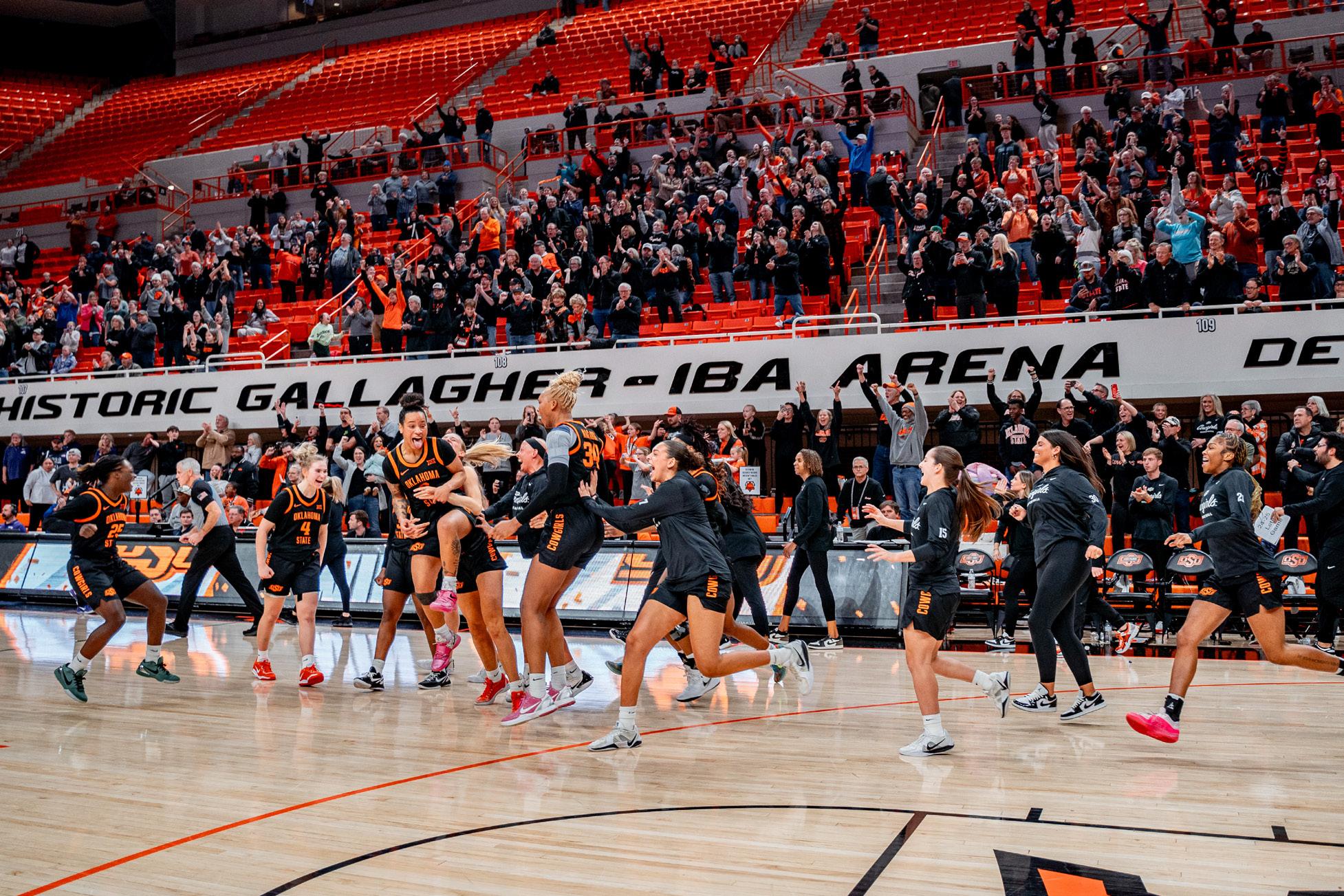
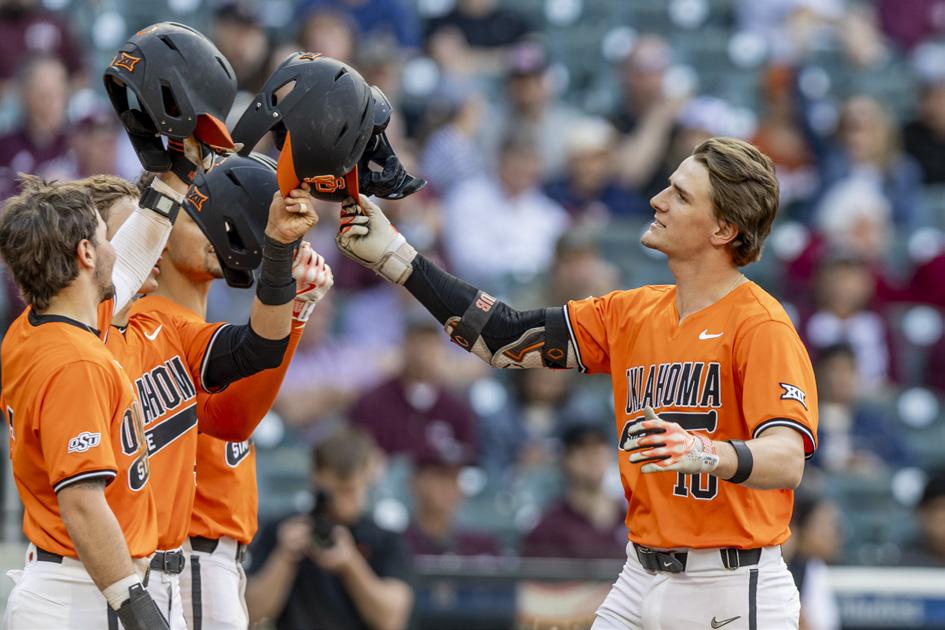

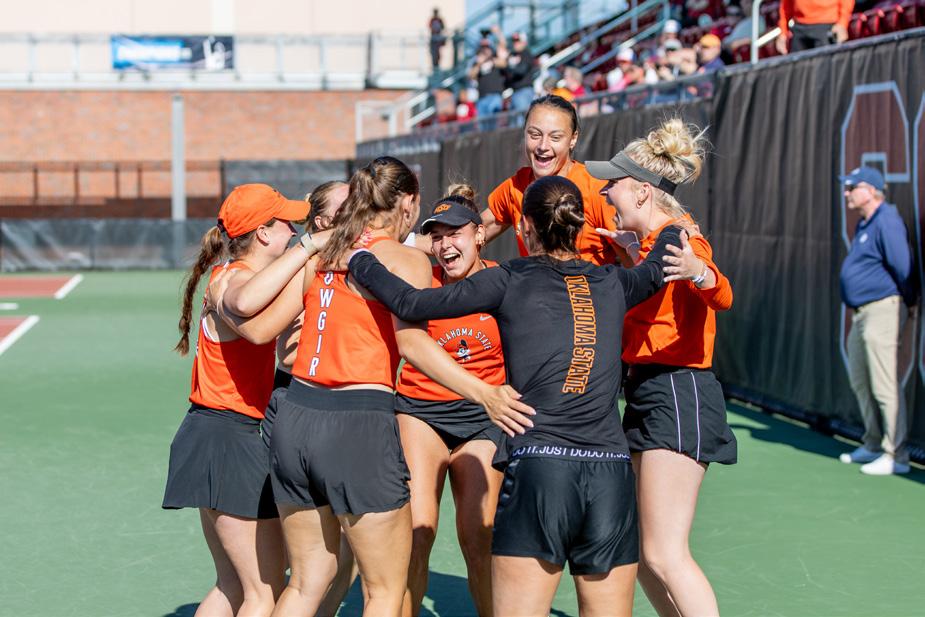














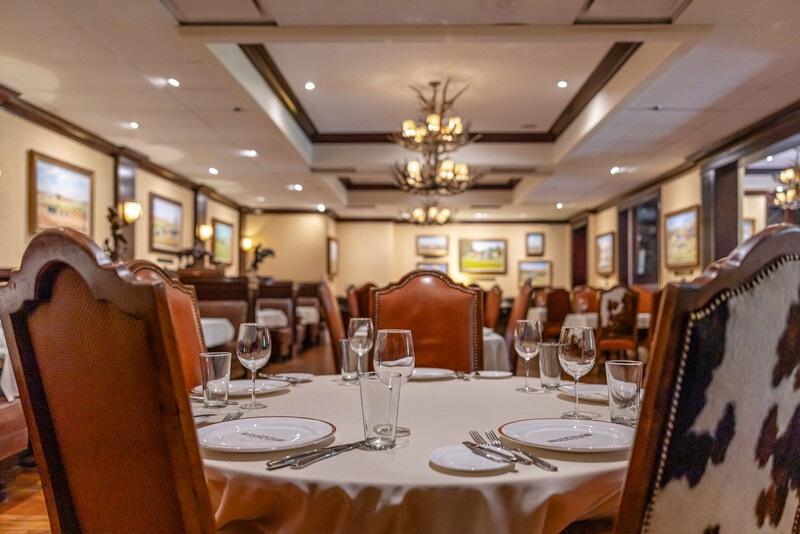


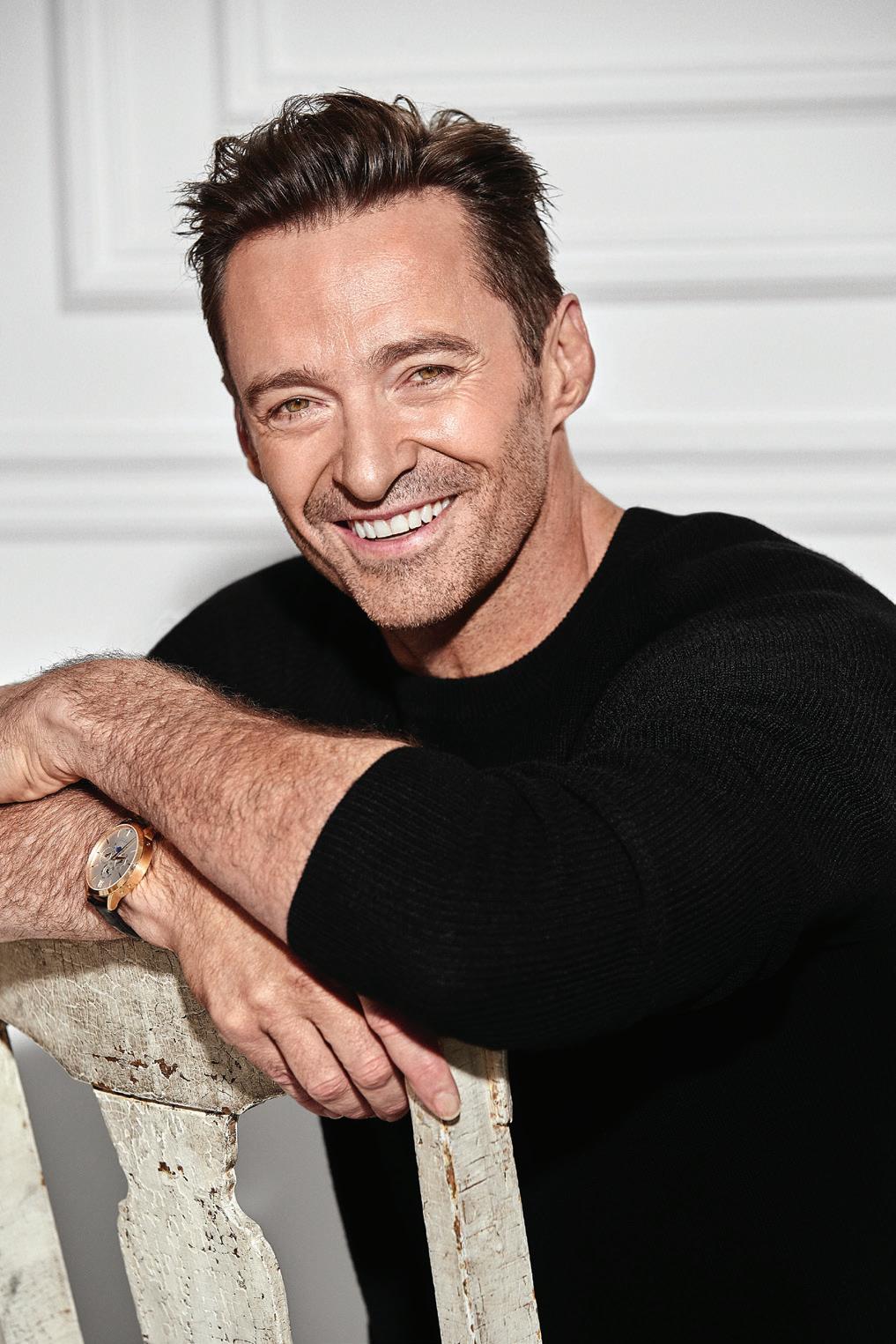





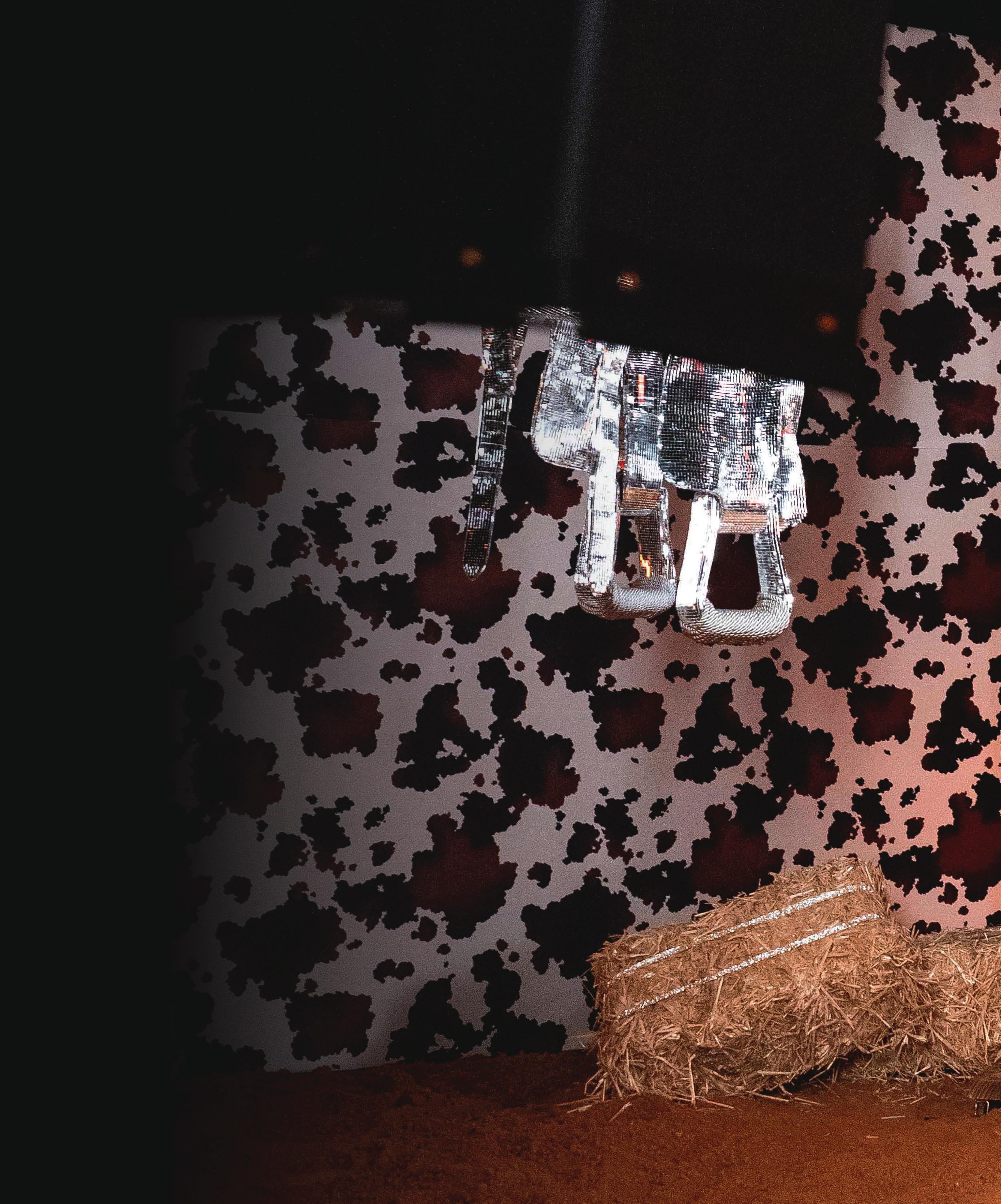
Welcome

Bruce Waterfield leads the visitors down a spacious hallway and through double doors, unveiling Boone Pickens Stadium’s hidden gem that frequently appears in plain sight.
Most Oklahoma State University sports fans haven’t stepped into this cavernous studio, yet they know its striking scenery from hype videos, gameday programs and recruits’ social media posts.
The mural adds the wow factor. Orange, gra ti-style letters gleam like mylar balloons, appearing to float in front of a wall bathed in strobe lights.
Waterfield, OSU Athletics’ photo services coordinator, roves around the set and snaps pictures of the guest of honor, a football recruit. The camera’s shutter sound fades into the booming beats of Kendrick Lamar and Jack Harlow songs. Waterfield raises a light stand, lowers another and takes more pictures, not pausing to ponder his next step. He just knows.
This is Waterfield’s home turf, quite literally. He stands on a rectangular green strip that brings an on-field aesthetic to the air-conditioned, perfectly lit indoor space.
The VIP strikes a serious pose in front of the mural, tipping the black cowboy hat that matches his pristine football uniform. Then he heads to a di erent photo station resembling an OSU locker room. Like a seasoned actor on a film set, he readily moves between scenes while his family admires the studio’s details.
Brimming with eclectic props and portable backdrops, it does have a dusting of Hollywood flair. From song selections to photo concepts, OSU’s creative team customizes the experience for the student-athlete, regardless of sport.
Click-click. Waterfield captures a meaningful moment.
A somewhat magical quality fills the air when young athletes put on Cowboy and Cowgirl uniforms for the first time.
“A dream is being realized,” said Addison Skaggs, assistant athletic director for digital strategies. “They’ve worked for this, and it’s the first step of the journey actually becoming real.”
Welcome to Studio 1890.
It’s a balmy summer evening in Stillwater, and Johnna Orange is reminiscing on OSU media days.
After five seasons on OSU’s track and field team, Orange has enough mementos to fill an album. The aptly named Cowgirl thrower from Tulsa relished the annual media days, representing her team through fun video clips and serious portraits in Studio 1890.







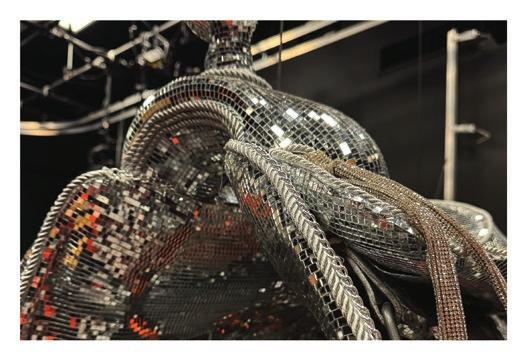


“It makes you feel like you’re a part of the university,” said Orange, the daughter of former Cowboy football player Vincent Orange. “It builds the hype and the culture around what we’re doing.”
Named for OSU’s founding year, Studio 1890 is a laboratory for OSU’s creative teams and Orange Power Studios, OSU Athletics’ in-house production hub. A dedicated crew of full-time employees works with a student sta er to produce multimedia content highlighting student-athletes and OSU teams throughout the academic year. And of course, every recruit who visits the OSU campus also gets their day in the sun — or under the lights in this case.
While trained in various skills, everyone has a specialization.
Waterfield, of course, is the photography expert. Creative content specialists Cooper Peacock, Kylie Vinson and Heath Vessels bring video and photo concepts to life.
Graphic designers Dylan Baisden, Kayla Ballero, Rod Hill and Jordan Smith turn Studio 1890’s photos and videos into themed works of art appearing on social media to celebrate signing days, gamedays and more.
C.J. Lickert provides leadership and support as OPS’ executive producer, along with his sta of Madison Brown, Tyler Blackburn, Scout Cooper, and Dylan Taylor
Tallen Parker keeps an eye on things as the social media coordinator and engineer Jeremy Webb keeps things running. The creativity on the big boards is usually produced by videographer/producer Graham Tewell, one of the first employees of Orange Power Studios.
Kevin Klintworth, senior associate athletic director for communications, is a constant advocate for the creative units, which he oversees, relaying their ideas to fellow administrators, coaches and encouraging work-life balance.
He knows how much their roles matter.
Studio 1890 leaves an impression on recruits, and if they choose OSU, that’s not the last time they see it. Each year, every student-athlete stops by for their sport’s designated media day, in reality a photo day, to help stock OSU o cial team accounts and the student-athletes’ social media platforms with images.
It’s a mutually beneficial process. OPS collects a bank of footage and photos to use throughout the upcoming season, while student-athletes showcase their personalities and build their public images through multimedia channels.
Orange, a 2024 sports media graduate, understands why OSU emphasizes visual storytelling. She also appreciates the logistics that go into each media day.
Since OSU’s track and field roster hovers around 100-120 athletes, it’s no small task to fit everyone into a schedule. Athletes sign up for time slots on a spreadsheet, and each small group is allotted about 45 minutes to interact with various media stations. Football media day is a similarly complex process that includes the production of social media images and content, as well as images and videos that appear on the Boone Pickens Stadium video boards on gamedays.
Just over 10 years ago, OPS completed its o ces, but the luxury of Studio 1890 wasn’t available. In the early days, photographers and videographers (a very small army at the time) worked out of a smaller black box studio equipped with a green screen and podcasting table. Although OPS continues to use that flexible space, it simply wasn’t enough for these massive media events — especially as the use of social media ballooned in regard to recruiting.
As content creation became increasingly important to college athletic departments and to the athletes themselves, OPS needed a crown jewel
“The kids have been trying to build their brand, even before Name, Image and Likeness (NIL), with social media,” said Todd Bradford, director of football recruiting. “That’s just been a continuation of where all athletes are going.”
It was time to find a larger space. Just down the hall, a humongous storage room o ered untapped potential.
The athletics sta had dubbed it the “Home Depot Area.”
When Skaggs, the OSU sports media graduate who had been serving as the creative director for Ohio State football, returned to work for her alma mater in 2022, the current creative studio looked more like a warehouse. With industrial ceilings and concrete floors, the room housed wood scraps, discarded items and old furniture.
Today, Studio 1890 contains remnants of its miscellaneous past lives, but it pops with considerably more pizzazz than your local hardware store.
“We want it to be cool,” Skaggs said. “We want it to be flashy. We want it to feel like an experience. Rather than just, ‘Stand here and smile,’ we want it to feel like the big leagues. So we add props, add the music, add the unique things to take it to the next level.”
High school recruits might have trouble imagining a world without this spotlight, but not long ago, things were di erent.
“For most of my coaching career, there was no photo shoot on their o cial visit,” Bradford said. “Probably the last 10 years is when that came into vogue.”
When Bradford coached OSU linebackers from 2005-07, OPS didn’t exist. Neither did the space known today as Studio 1890.
In 2009, Boone Pickens Stadium unveiled its largescale renovations, which included a nameless space tucked away on the third floor, or arena level, as it’s noted on elevator buttons.
This blank canvas cycled through temporary purposes.
The football team used the room for walkthroughs prior to the construction of the Sherman Smith Training Center, evident in the white yard lines streaked across the concrete floor. As big as a ballroom, the space was ideal for social distancing when OSU Athletics adapted to the COVID-19 pandemic. Somewhere in the room’s bizarre history, there was an indoor long jump ramp and pit. Eventually, the space provided storage for Cowboy Dining, the in-house unit preparing meals for stadium suites and the student-athletes’ training table.
Since Studio 1890 is located between Cowboy Dining and Orange Power Studios, the aroma of savory food sometimes wafts into the room. That certainly doesn’t hurt recruiting. But the studio, no longer viewed as an extra space or warehouse, boldly wears its new identity.
A little imagination goes a long way.
A decal resembling a wooden basketball court covers one wall. A denim jacket bedazzled with pearls and orange “Cowboys” script hangs over a chair.
Much like Studio 1890, Skaggs’ o ce bursts with vibrant personality.
Her creative eye traces back to her high school days of designing theater sets in her hometown of Perryton, Texas. Now, she reads posts in Facebook groups for high school theater teachers, hoping to borrow their clever arts and crafts ideas. Come to find out, stage crafting isn’t so di erent from assembling Studio 1890’s delightfully unusual inventory of props.
Sometimes, Skaggs tapes a sign on the studio’s door: “Excuse our mess as we build the future of Studio 1890.”
“It’s always under construction because we’re trying to keep up with the trends and keep it fresh,” Skaggs said.
Skaggs has an incredibly busy job. She supervises student videographers and juggles overlapping sports schedules, directing in-house coverage of every OSU team except for football, which has its own crew. And that doesn’t include the non-stop flow of prospective student-athletes. We call those recruits.
Sometimes, her responsibilities take an eccentric turn. Skaggs searches far and wide, rescuing random Facebook Marketplace finds and turning them into Studio 1890’s treasures.
Many would dismiss a chair patterned with a beer company’s logos as too gaudy. Skaggs, however, knew she could work with the seat’s distinctive baseball-glove shape. Like a house flipper on HGTV, she gave it a fresh start, covering the logos with black and orange paint. Another time, when POSSE members Jim and Debbie Bellmon donated a Western saddle, Skaggs decorated it with disco tiles to shine in the background of a Cowgirl soccer photo shoot.
One afternoon not long ago, Klintworth walked in on Skaggs bedazzling the saddle in the studio. He observed for a few seconds without saying a word and then continued his journey down the hall.
“Just another day in Addison’s world,” he said.
Video producer Vessels also puts his thinking cap on — or maybe it’s a hard hat. Vessels built Studio 1890’s eyecatching display of Cowboy football helmets spanning various eras. He also fashioned the walls on wheels, making it mobile.
We want it to be cool. We want it to be flashy. We want it to feel like an experience.” “
— Addison Skaggs
“He might be our resident carpenter,” Skaggs quipped. “We need to add that to his title.”
OSU has reached outside the athletic department for ideas, too. Tulsa-based artists Logan Rogers and Becs Burroughs created the gra ti mural, a permanent fixture of a shape-shifting studio.
While some elements serve as aesthetic backdrops, others are interactive. An assortment of cowboy hats — orange, black, turquoise and disco-tiled — awaits in the studio for athletes to try on.
Some bring their own props.
“They let us have full creativity,” Orange said. “One of my teammates brought his guitar and was pretending to play while he was taking a picture. Another one of my teammates had a Superman outfit underneath a white T-shirt, and it was really tough.”
Photo shoots aren’t limited to the studio. Often, recruits pose on the football field with a horse, a memorable addition to any o cial visit. But, because of the controlled indoor environment, Studio 1890 o ers the greatest creative
freedom. Windows are covered, allowing Waterfield and his colleagues to precisely adjust the lighting.
“It’s evolved into this huge show of lights, camera, action and music,” said Chris Deal, director of football creative services. “From the beginning stages to the show, it’s been fun to be a part of it.”
As student-athletes seek NIL partnerships, the “show” gives them publicity while organically promoting OSU. When a student-athlete goes live on Instagram from the studio, the broadcast reaches audiences beyond OSU Athletics. For example, a large proportion of top men’s basketball recruits in America followed former Cowboy superstar Cade Cunningham on social media, Skaggs said.
If those recruits saw Cunningham having fun at an OSU photo shoot, the Cowboys’ reputation grew. If one of those recruits chose the Cowboys, then that young star could enhance his media presence with content from Studio 1890.
“The most important piece we hold in the NIL space is building the OSU brand as big as possible so that when the athletes are part of it, they get a little boost on their personal brand,” Skaggs said. “We can continue to lift them up, the higher the OSU brand gets.”
It’s About the Journey
Marshall Oliver visited OSU with his son, a promising recruit from Edmond Santa Fe High School.
A few whirlwind years later, Oliver heard his son’s name called during the 2025 NFL Draft. At No. 159, the Green Bay Packers drafted Collin Oliver. The standout edge rusher rose to national stardom with the Cowboys, and when his father looks back at pictures from OSU’s media days, he marvels at Collin’s growth.
“One of the biggest things you see is how he developed from this skinny little kid to this big-time college football player,” Marshall said.
The physical progression isn’t all he noticed. As Collin matured, he grew more comfortable representing his team in the media spotlight.
“You see something di erent about him each year,” Marshall said. “You see those changes they go through, growing into that leadership role as he gets years behind him being part of the program.”
For athletes’ parents, Studio 1890’s photos are sentimental reminders of their kids becoming adults. Marshall witnessed Collin’s milestones on the field and in the classroom, where he earned his marketing degree in three-and-a-half years.
When Collin graduated, his family members weren’t the only proud supporters.
Waterfield treasures the annual cap-and-gown photo shoots at OSU Athletics’ graduation receptions. Although the transfer portal requires Waterfield and his colleagues to constantly learn new names, some student-athletes, like Oliver, spend their entire college careers at OSU. The creative team not only knows the athletes, but also bonds with their families
“At the end of the day, it’s not just about athletics,” Waterfield said.
Peel away Studio 1890’s glitz and glamour, and it’s driven by genuine care.
Waterfield has a big heart. He knows his job is about uplifting people, and Studio 1890 allows him to do just that.
“When you’re taking pictures, you want somebody behind the camera that’s going to be respectful, yet still hype you up,” Orange said. “He’s so fun, and it’s nice to have somebody that you can feel comfortable around.”
“When Bruce decides to hang it up, we will have to replace him with four photographers,” Klintworth said.

Waterfield can end up with hundreds of pictures from one photo shoot, selecting the best ones to edit. He finishes the job in less than a day or two. OSU makes its galleries available to athletes and their families on Pixieset, a program where they can easily select and download photos.
Orange has posted several on social media. She scrolls through her phone until she finds her favorite.
It’s a side-by-side comparison between her freshman year and final season on OSU’s track and field team. She intentionally recreated her original pose, standing tall, crossing her arms and facing the camera. Enhancing OPS’ work with her own media skills, Orange combined the photos in a digital collage, a reminder of her unique story.
Unlike many peers, Orange didn’t have a recruiting photo shoot. She enrolled at OSU not expecting to play sports. Then, realizing she missed her high school days as a multisport athlete, Orange tried out for track and field, growing from a Cowgirl walk-on to a scholarship holder who earned 2024 outdoor All-Big 12 honors in the hammer throw.
In the photos, her orange uniform shows team pride. Her confident pose reflects individual perseverance
OSU’s creative team makes sure she always remembers both.


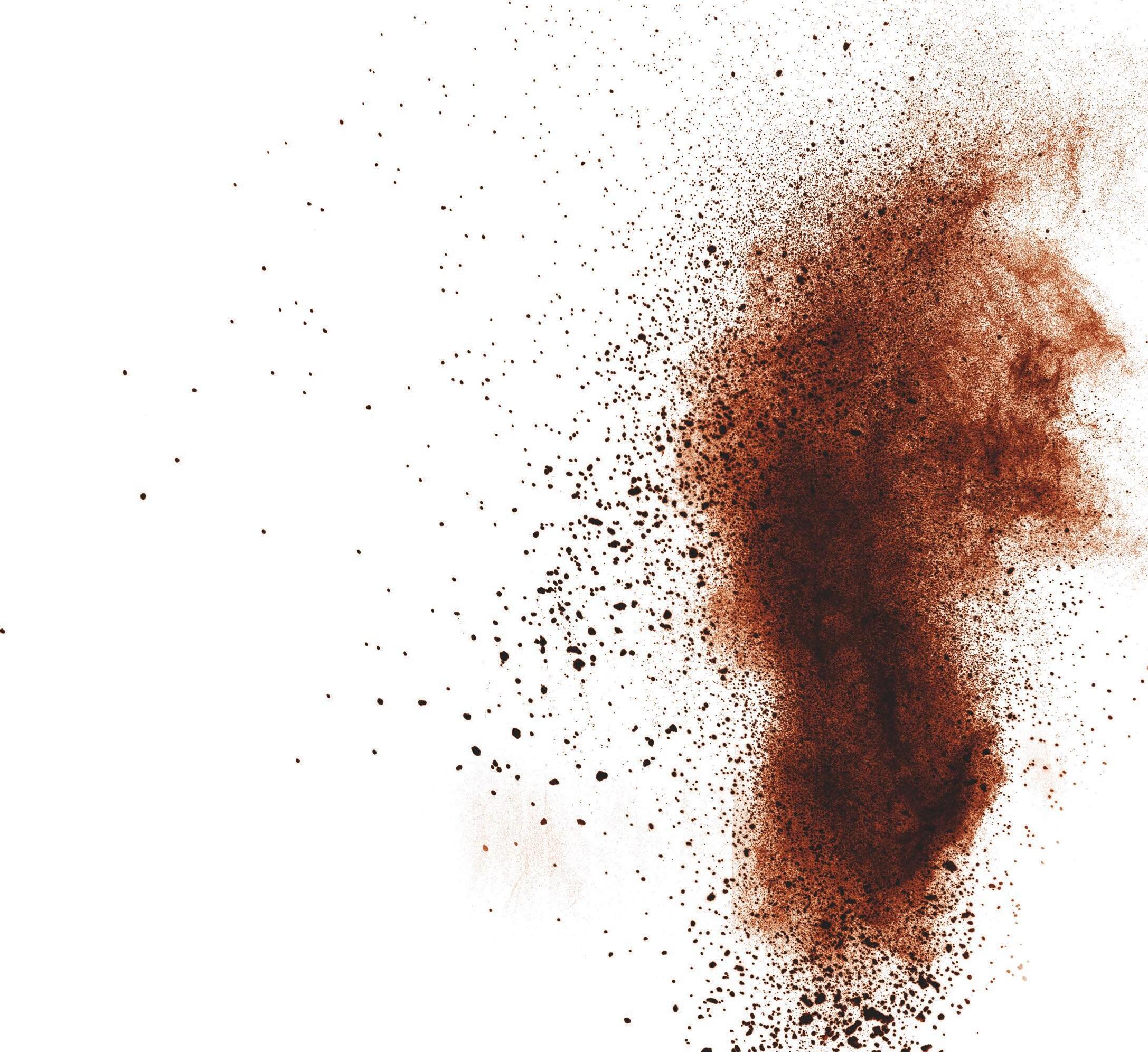





On April 26, the OSU POSSE Auction welcomed Cowboy Basketball and NBA great Tony Allen back to Gallagher-Iba Arena as the guest of honor. Known as the “Grindfather” for his relentless defense and work ethic, Allen was joined by teammate Daniel Bobik to reminisce about the 2004 Final Four and Big 12 championship season.
Raising nearly a quarter of a million dollars for the Athletics Excellence Fund, the dinner/ auction continues to be Oklahoma State’s single largest fundraising event for Athletics.
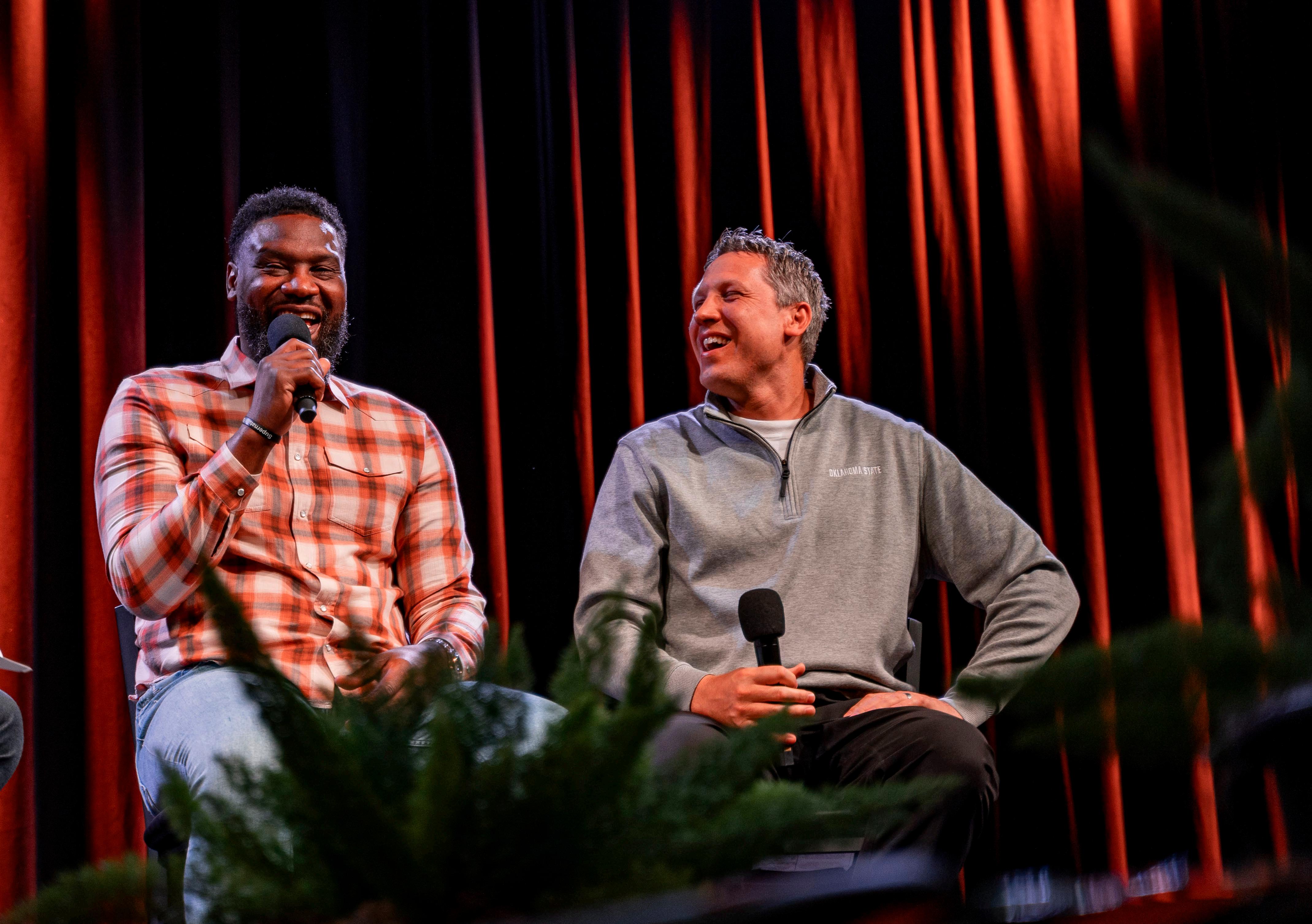




Cowgirl Annie Molenhouse reacts to winning the Heptathlon following the 800 meter run at the 2025 Big 12 Outdoor Track & Field Championships. The junior from Batavia, Ill., scored 5,729 points on her way to becoming OSU’s first multi-event athlete to win a conference title. Molenhouse went on to earn second-team All-America honors at the NCAA Championships. The Heptathlon is comprised of seven events: 100 meter hurdles, high jump, shot put, 200 meters, long jump, javelin throw and 800 meters.




